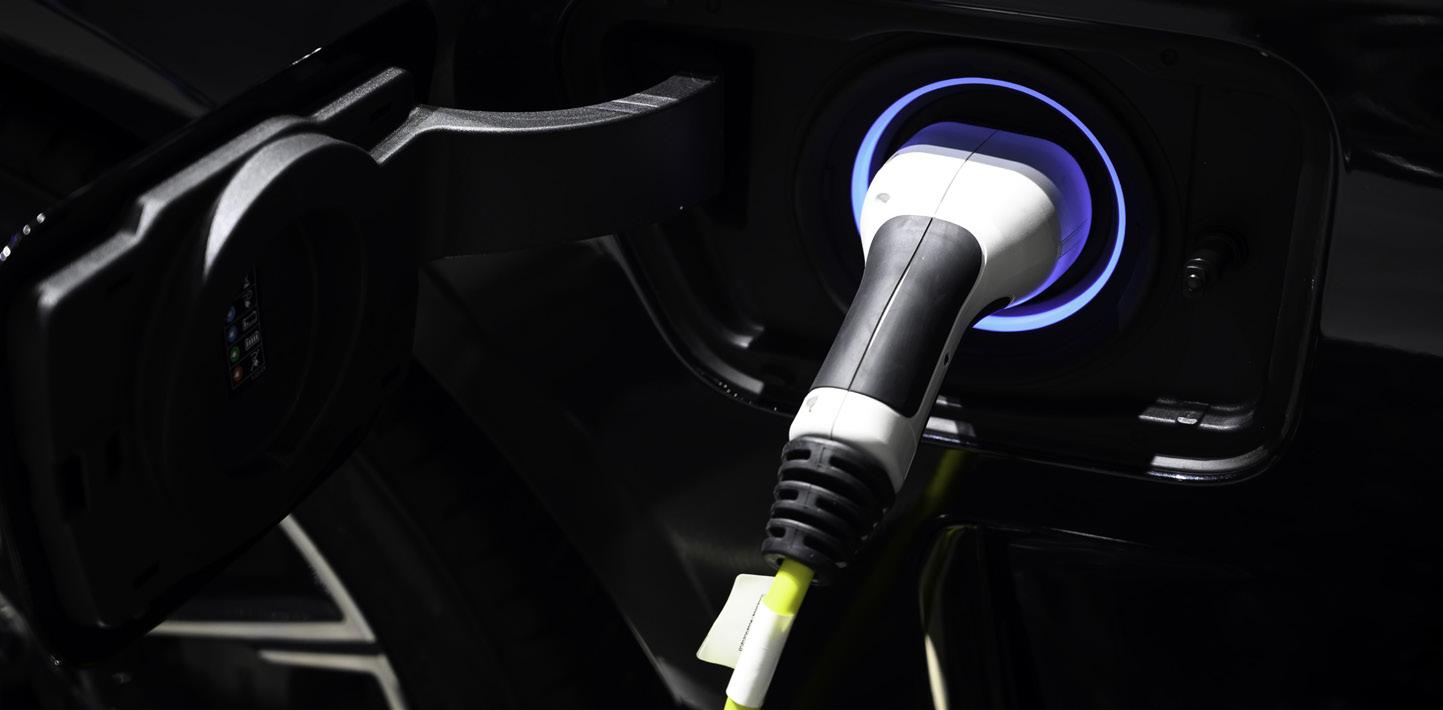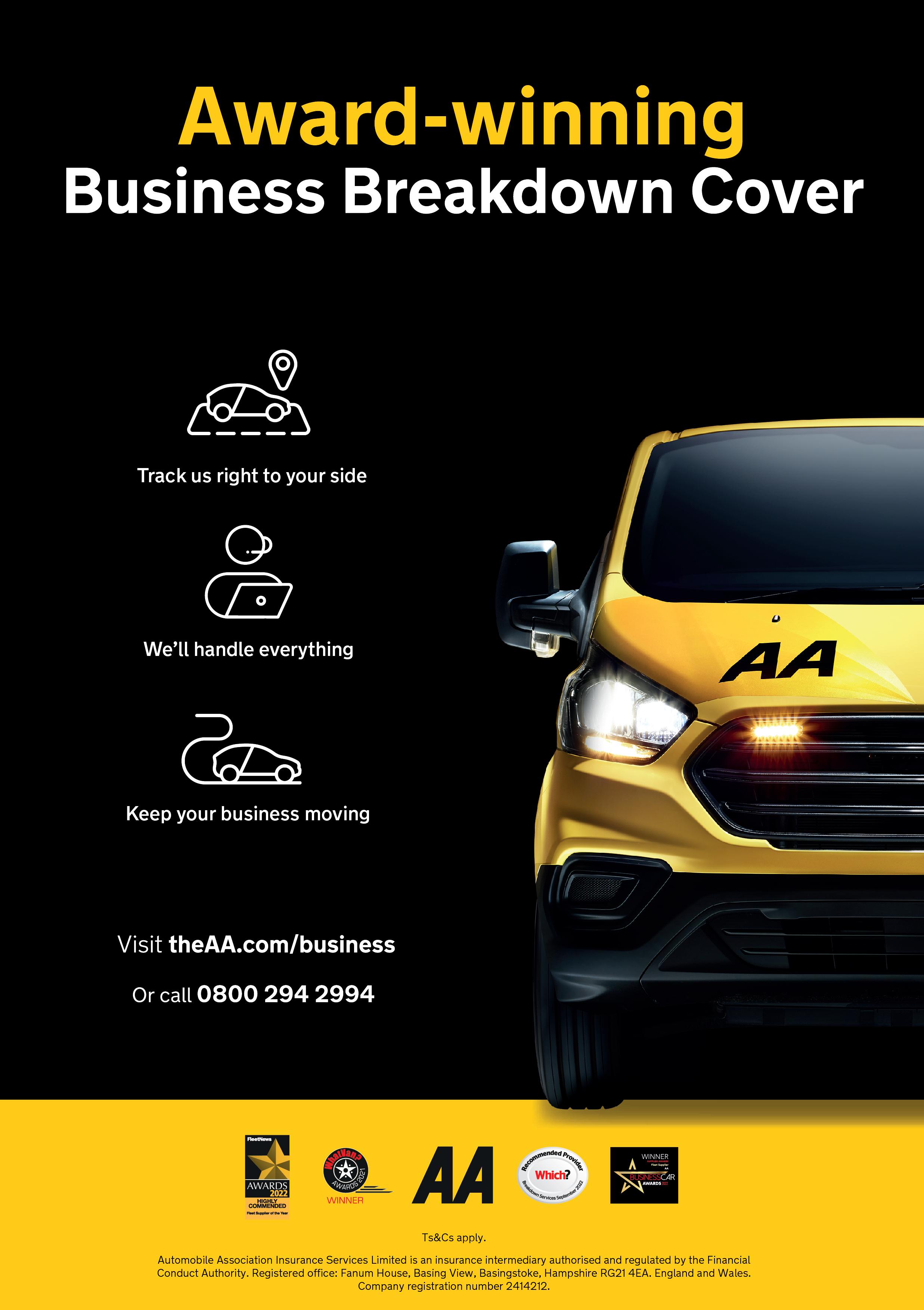






















Visit greenfleet.net for the latest news, features, road tests and interviews



This issue of GreenFleet takes a deep dive into electric vehicle charging –whether that’s on the public network, at work or at home.
The recent release of draft public charge-point regulations seems to address the issues that drivers are experiencing when charging out and about, namely chargers that are not working or occupied, and the different payment and sign up requirements.
The regulations stipulate an average of 99 per cent reliability each year, clearer pricing, contactless payment and open data. While the regulations are up for debate in parliament, they are expected to come into force later this year. We look at the details of the regulations, and what this means for fleet drivers, on page 15.
GreenFleet’s very own EV Rally took place in early July and was the ultimate test of the public charging infrastructure – covering over 1,200 miles and visiting all capital cities of the UK and Ireland. With a more diverse mix of vehicles this year, including two electric trucks, turn to page 37 to find out how teams got on.

On page ten, Matthew Adams, transport policy manager at the REA, examines the recent Recharge UK report, which looks at how to make the future charging infrastructure a success, including ensuring it meets the needs of van drivers.


And Ian Johnston, chair of the newly formed trade association ChargeUK, tells readers what the organisation hopes to achieve as the voice of the charging infrastructure industry, on page 20.
Angela Pisanu, editor

To register for updates, go to www.greenfleet.net/greenfleet-registration or contact Public Sector Information, 226 High Road, Loughton, Essex IG10 1ET. Tel: 020 8532 0055
GreenFleet® would like to thank the following organisations for their support:
PUBLISHED BY PUBLIC SECTOR INFORMATION LIMITED


226 High Rd, Loughton, Essex IG10 1ET. Tel: 020 8532 0055 Web: www.psi-media.co.uk
EDITOR Angela Pisanu PRODUCTION MANAGER/DESIGNER Dan Kanolik
DESIGNER Jo Golding
© 2023 Public Sector Information Limited. No part of this publication can be reproduced, stored in a retrieval system or transmitted in any form or by any other means (electronic, mechanical, photocopying, recording or otherwise) without the prior written permission of the publisher. Whilst every care has been taken to ensure the accuracy of the editorial content the publisher cannot be held responsible for errors or omissions. The views expressed are not necessarily those of the publisher. ISSN 2399-4940
GreenFleet is a member of the Independent Press Standards Organisation (which regulates the UK’s magazine and newspaper industry). We abide by the Editors’ Code of Practice and are committed to upholding the highest standards of journalism. If you think that we have not met those standards and want to make a complaint please contact Angela Pisanu or Polly Jones on 0208 532 0055. If we are unable to resolve your complaint, or if you would like more information about IPSO or the Editors’ Code, contact IPSO on 0300 123 2220 or visit www.ipso.co.uk
The most cost-efficient and scalable DC charging solution on the market




Rolec EV’s latest DC ultra-rapid charging station is the most intelligent, modular and scalable solution for your electrified fleet.
The ULTRACHARGE 160 is packed with the latest charging and safety features and o ers up to 160kW charging speeds, making it ideal for fleets of all shapes and sizes.



Hydrogen transport projects in North East receive funding; Royal Mail launches fully electric drone deliveries in Orkney; Government urged to address electric vehicle skills gap
10
Fleets play a pivotal role in keeping our country running. Matthew Adams, transport policy manager at the REA discusses how best to empower fleet operators to switch to electric, ensuring their needs are met when charging infrastructure is designed
15 Charging
The government has published draft regulations for public electric vehicle charge points, which stipulate better reliability, clearer pricing, contactless payments and open data. So what does this mean for fleet drivers?


20
The electric vehicle charge point sector has grown massively over the last decade, but there are still some big obstacles to overcome to get the infrastructure we need. That’s why 22 of the major companies responsible for the UK’s charging infrastructure have come together to form ChargeUK. Chair Ian Johnston explains what the organisation hopes to achieve
25 Depot Charging
North Tyneside Council’s Killingworth site depot is the scene of a new energy ecosystem, which uses a solar PV array, battery energy storage system, and chargepoints to support its electric fleet. We speak to Ian Lillie, the Council’s strategic facilities manager, for more details on the project
Vehicle electrification will no doubt be in the minds of fleet operators, as the 2030 deadline for the end of new petrol and diesel vehicles comes closer. With around 80 electric models available, attention has now turned to how these vehicles will be charged. We ask our expert panelists to discuss all things charging infrastructure – from workplace, home and public charging, to ensure any charging strategy is successful
After being named the media industry’s ‘Event of the Year’ in 2022, the EV Rally pushed the boundaries even further this year, with a more challenging route, a more diverse mix of vehicle sizes, and more participants – all with the aim of testing how electric vehicles and public charging infrastructure measure up. So how did the teams get on?
Earlier this Summer, the Urban Mobility Partnership – a coalition of sustainable transport providers – hosted its inaugural summit in Birmingham, to discuss how to incentivise a modal shift towards public transport, micromobility and multi-modal options
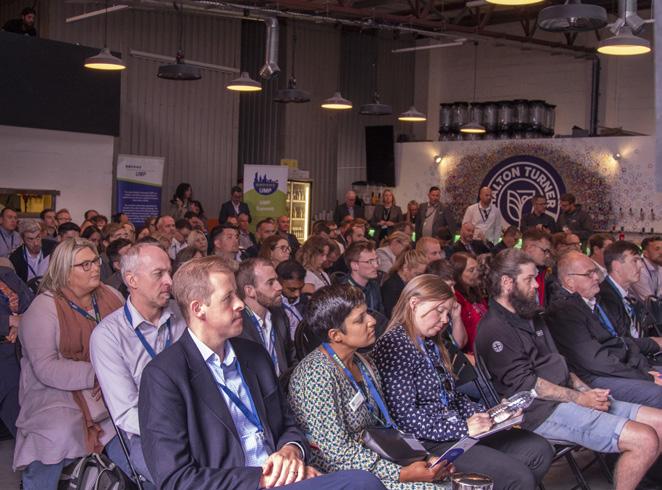
50 Roundtable: R2Z Cymru
GreenFleet’s roundtable at Baglan Bay Innovation Centre in Port Talbot, Wales, got into the detail of energy strategies, delivering public charging infrastructure and the imminent ULEV targets


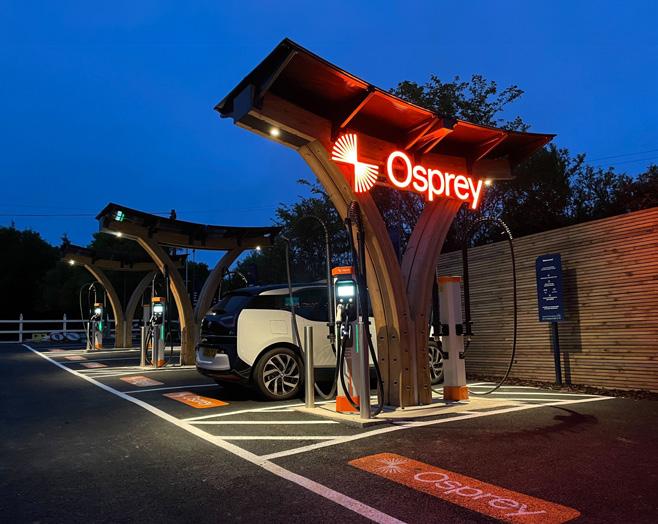
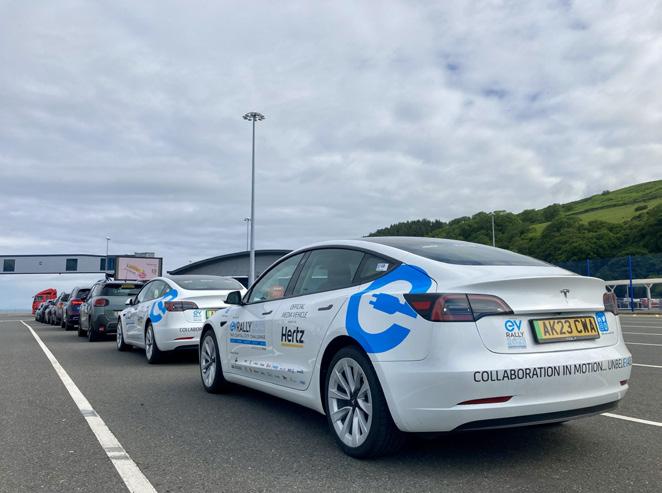
52 Road Test: Renault Pro+
Building on its rich electric light commercial vehicle heritage, Renault Pro+ has introduced an all-new zero-emission version of the Kangoo. Richard Gooding discovers a more accommodating and more powerful vehicle with much fleet appeal

54 Road Test: MG5 EV
With its practicality and long range capability, the MG5 EV has been a favourite with fleet drivers since it first appeared in 2020. Now, there’s an updated model with a new look and on-board technological innovations. Richard Gooding finds out if these new features affect the core of what made the old model popular


The other project is led by Element 2 and aims to create new hydrogen refuelling stations, helping to provide the infrastructure needed to scale up the use of hydrogen as a fuel. This funding will create four new publicly accessible hydrogen refuelling stations, increasing the number of refuelling stations in the UK by 50 per cent. These will be used to fuel a range of vehicles, from airside vehicles to heavy goods vehicles (HGVs), including supermarket delivery trucks.
in developing hydrogen tech. This investment will provide a further boost to the economy, creating skilled jobs and apprenticeships across the North East.”
This funding brings the UK closer to decarbonising some of the heavier and more complex vehicles, such as airside operations, which will be essential in reaching net zero. Already used in buses across the country, hydrogen fuel cells create no harmful exhaust emissions.
Two projects in the North East will receive a share of £8 million funding to develop innovative hydrogen transport solutions. One project led by ULEMCo will develop hydrogen-powered airport ground-based support vehicles, such as tow trucks for aeroplanes and sweepers to clean runways. This will be based at Teesside international airport, which will help the airport reach its goal of being net zero by 2030.
The announcement also confirms £300,000 delivered directly to colleges in the area to support upskilling the local workforce and foster a specialised skills base and pipeline of talent, further cementing the Tees Valley’s status as the home of hydrogen.
Transport Secretary Mark Harper said: “Hydrogen technology has great potential to decarbonise transport and help grow the economy.

“These winners illustrate the expertise the Tees Valley has as a pioneer
The funding also marks the continued growth of the UK’s only hydrogen transport hub, attracting even more innovation, investment and jobs to the Tees Valley. The competition invited ideas on how to overcome some of the challenges of scaling-up hydrogen technology, such as refuelling on a large scale and making the region’s supply chain greener with hydrogen-fuelled vans and HGVs.

This is due to the unique landscape of Orkney and the proximity of the islands to one another. This allows for flights to be conducted using extended visual line of sight (EVLOS) permissions rather than beyond visual line of sight (BVLOS) permissions.
Letters and parcels will be transported from Royal Mail’s Kirkwall delivery office to Stromness, from where Skyports Drone Services will conduct drone deliveries to Royal Mail staff on Graemsay and Hoy. From these locations, postal workers will then carry out their usual island delivery routes.
The weather and geography of Orkney can impact the ability to provide an uninterrupted delivery service. For example, pauses in the ferry schedule - by which some mail is transported - are common during poor weather due to the challenges of docking safely. The I-Port operation significantly improves service levels and access for rural communities, significantly shortening delivery times to Graemsay and Hoy.
Royal Mail is introducing a drone delivery project established in partnership with Orkney Islands Council Harbour Authority and Loganair, and fulfilled by Skyports Drone Services. The companies have established a daily inter-island mail distribution service between
three islands on Orkney. The project will initially operate for three months, with the intent to extend in the future.
This is the first UK drone delivery project which can be conducted on a permanent basis under existing regulatory frameworks.
The use of electric drones for interisland delivery will also bring significant safety improvements, ensuring postal workers can deliver between ports and marinas throughout Orkney without risk. There will also be emission savings. Skyports Drone Services will conduct the inter-island flights with the Speedbird Aero DLV-2 aircraft. The multirotor drone is capable of carrying payloads of up to 6kg.
ALTERNATIVE FUELS

Heating and plumbing company TG Lynes has introduced Hydrotreated Vegetable Oil (HVO) into two of its 18 tonne Euro 6 lorries late last year.
HVO is a cleaner alternative to diesel and is manufactured from 100 per cent renewable and sustainable waste, including vegetable oil, tallow and used cooking oil.
The lorries are refuelled by a 10,000 litre HVO tank installed at its Enfield base, producing additional benefits including significant time efficiencies and cost savings.
The switch has proved so successful both environmentally and economically that TG Lynes is now considering rolling out HVO across all of its heavy goods vehicles.
REFUSE TRUCKS
The projected carbon saving through the course of 2023 through the two HVO lorries is 15 tonnes – the approximate amount an average car would emit were it to drive once around the world.
John O’Connell, transport supervisor at the business, said: “We made the decision to try HVO in two vehicles to see how it worked.
“We knew that our carbon emissions from these two vehicles would reduce by around 90 per cent, but we hadn’t fully appreciated the additional benefits the move would bring.
“The MPG of each vehicle has improved. These Class 2 vehicles tend to do quite

authority by 2030 with a borough target of achieving carbon net-zero status by 2050,’ commented Councillor Kevin Blake, Cabinet Member responsible for Carbon Reduction.
“I am pleased that we are the first local authority to offer a zero-emission food waste collection service in the UK,” said Russell Markstein, chief commercial officer, NRG Riverside.
short journeys within the M25 with plenty of stopping and starting.
“When we were using regular diesel the MPG averaged 11.5. During a similar month this year, with comparable journeys completed, it was 13 MPG.
“Furthermore, lorries of this size need to use specific fuelling stations to re-fill with diesel. This takes planning and time. With our HVO tank on site, there is no queuing or forethought required – the fuel is waiting each morning, allowing us to get on with our deliveries.”
READ MORE
EV charging company Mer is supporting the AA’s electric breakdown vehicles by installing chargers at the drivers’ homes, where the vans are parked over night. The AA also required EV chargers that were compatible with Mina Homecharge. This is a software platform which ensures that employees don’t pay for charging work vehicles at home, as the employer is billed directly.
Basildon Borough Council has rolled out seven fully electric food waste trucks as part of a contract hire agreement with NRG Riverside, which includes full service and maintenance provision, saving the local authority over 900.000kg of CO2 over the contract’s lifetime.
Basildon’s first high-spec 12.5tonne Electra eCargo went into service in April 2023, with the entire fleet operational at the beginning of July.
The vehicles have been provided on contract hire by NRG Riverside, allowing the Council to benefit from the latest low-emission vehicle technology without requiring a large cash outlay, no risk and fixed price over the agreement term.
The Electra eCargo Micro XHD vehicles feature a payload of 7900 kg with 140kWh battery capacity and a range of up to 250 km. The 150 KW DC fast-charge capability means the trucks can be double-shifted and exceed their range by over 100 miles in under an hour. Having been designed with a very short wheelbase of 3330 mm makes them easy to operate and manoeuvre in busy city centres and narrow streets.
“Basildon Borough Council spent considerable time reviewing the services we offer to our community and ways to assist climate change issues within the borough. We are working hard to become a carbon net-zero
“We have been working in partnership with Basildon Council since 2011, when we developed a high-tech workshop together while taking on the local authority workshop staff. We helped fulfil the Council’s ambitions by working with local colleges to create an apprentice scheme and recruiting local apprentices and engineers.
“We have supplied Basildon with the highest quality vehicles since we first worked together. Our arrangement started with providing the cleanest Euro V diesel trucks and equipping the entire waste collection fleet with all-electric bin lifts. Now, we have reached another milestone by delivering the country’s first municipal fully electric food waste fleet to Basildon in record time.”
Ben Smith, MD, Electra Commercial Vehicles, commented: “The eCargo is the perfect solution to meet the requirements of the Government’s new food waste collections regulations nationwide. Basildon’s new trucks are the first electric waste collection vehicles in the 12.5-tonne weight range and size. We are delighted that Basildon is the first local authority in the country to roll out a fully electric food waste collection service thanks to another of our groundbreaking zero-emissions waste platforms.”
Simon Ungless, group fleet manager for the AA said: “For our roll-out of electric patrol vans we needed a partner who could make the entire process simple and hassle-free for our drivers. Mer is able to provide an end-to-end solution, from procurement and installation to service and repair. Every installation to date, including my own, has been very smooth and straightforward.”
Emma Spark, head of business charging for Mer, said: “We are extremely proud to be supporting the AA’s roll-out of all-electric first response vehicles. While this is an ongoing process, we are already working with other elements of the AA to look at further expanding our relationship.”
Mer installs 7kW chargers at the homes of AA van drivers, enabling them to fully recharge the vehicles overnight. The smart charger also integrates with Mina Homecharge. In addition, AA drivers can access Mer’s public charging network via the Mer Connect app.
Emma added: “Mer understands the EV charging procurement and installation process from start to finish. Our expertise coupled with our position as an independent provider enables us to go above and beyond a standard installation for the AA. We were able to supply the right charging infrastructure for its drivers, while also providing additional integration capabilities for the AA as a business.”
Fast, slow, rapid, standard, ultra, mega, super – all names used for chargepoints here in the UK, but they’re not consistently applied to common power bands. Bringing in an international dimension, it gets worse; the names used elsewhere often vary even more and have been leaching into UK brochures and websites. Couple this with the folly of just counting chargepoint numbers without any reference to their capability (ie a 350kW charger can theoretically deliver 70 times the energy of a 5kW lamppost one) and we have a recipe for confusion and uncertainty about our recharging infrastructure. So it’s no wonder that the less ‘EV savvy’ can get confused and, consequently, deterred from making the switch to electric.
Of course the excellent Zapmap statistics have become the de facto standard, but the latest regulations don’t fully align with their bandings and even they agree the situation is far less than ideal where words like ’Fast‘ do not help users understand what they should expect or how they should use a charging opportunity.
So, at Zemo we’ve been working in the background to coordinate a common approach. I’m pleased that the community has now agreed a set of power bands by which we group chargepoints (<8kW, 8-49kW, 50149kW and >150kW). But the question of what label we should use for each band and how to describe their use pattern and typical locations, still remain.
One school of thought is to adopt an approach similar to mobile phones. No one really knows what a ‘G’ is or how fast it will be, but we know that 5 is better than 4 (and 2 and 3 are being switched off!). Personally I’m not a fan of this, since as we know home (or standard or slow?) charging below 8kW is actually the bulk of charging done today and is likely to remain so. It’s also the main area where ‘Smart’ or even bidirectional charging will happen. So calling it ’slow‘ might send the wrong message about its usefulness. And is ‘rapid’ better than ‘fast’ or ‘high speed’?
To help develop our thoughts, Zemo has published a survey for newsletter readers to have their say on how to name and describe chargepoint bands. Of course we really need to ask the non-EV driving community what will work for them, since readers of this magazine are likely already very well attuned to the charging questions, but to narrow down our options we’d welcome your views. Of course, as GF readers will also know, charging is more complex than just the power output of a chargepoint, with vehicle capability, charging curves, battery conditions and power-sharing all potentially impacting the activity. But helping drivers choose the right charger for their situation and journey and then delivering on the expectation will help us all make the shift to zero emissions more quickly. With the new bandings hopefully being adopted later this year, Zemo definitely support labelling (and communicating) the chargepoint power capability clearly. But as I’ve said before, words matter and consistency in how we name and describe chargepoints is a crucial first step to helping educate and encourage the next cohort of drivers into EVs. So, please do have your say on chargepoint terminology, to help us work with the wider community on the right names. As George Herbert said, “good words are worth much and cost little”. Zemo

Recharge UK, the EV arm of the Association for Renewable Energy and Clean Technology, believes a key issue across the EV industry going forward will be a lack of skilled professionals who are able to install and maintain charging infrastructure or maintain and repair electric vehicles.

As the charging industry is expected to increase chargepoint numbers from over 40,000 charge points today to the Government’s target of 300,000 by 2030, the limited skills pool will be severely under-resourced to manage the rising number of charge point installations and charge point manufacturing. In addition, there will be an increasing workload involved in maintaining charge points once installed. With Tata recently confirming plans to build a new Gigafactory in the UK and providing up to 4,000 direct jobs, RECHARGE UK is urging the UK Government to address the green EV jobs skills gap. This issue was addressed in Recharge UK’s new report, which is the EV arm of the REA (Association for Renewable Energy and Clean Technology), and provides a roadmap of how the industry can accelerate chargepoint deployment to keep up with the growth of EV sales in the UK.
Matthew Adams, transport policy manager at the REA (Association for Renewable Energy and Clean Technology) said: “With the announcement
that Tata have agreed to invest £4bn in the UK to build a new gigafactory providing up to 4,000 direct jobs, the recommendations in this report need to be implemented as soon as possible. EV infrastructure from chargepoints to gigafactories must be prioritised in grid connection queues to maximise EV availability and adoption, which will realise the greatest carbon savings.
“It is clear therefore, that the Government must launch a green jobs campaign that provides opportunities for new entrants to the job market and empowers the existing workforce to upskill and retrain for the significant opportunities that are available to them, especially given announcements like Tata’s. RECHARGE UK will be producing a skills report in November which will provide more details on how to harness the existing skilled workforce and young talent who want green jobs across the electric and low carbon fuels sectors.
“By 2030 there is expected to be a shortfall of 25,100 EVtrained TechSafe technicians. The Government should reform the Apprenticeship Levy so that a portion of unspent Levy funds could go toward priority training areas, including electrification, decarbonisation and digitalisation.”
READ MORE

What’s in a name? We need to clarify what we call our chargepoints

Readers of Green Fleet probably don’t need this pointing out to them but feedback from AFP members is suggesting that electric vehicle (EV) charging is replacing maintenance as the most onerous day-to-day managerial task facing them. In terms of maximising operational efficiency and minimising costs, it’s simply taking up huge amounts of time.
Over the last few years, maintenance has been the most prominent everyday issue facing fleet managers. The fleet car and van parcs have been ageing at a rapid pace while workshop capacity has been stretched and parts availability has been patchy. However, we now seem to be in a position where charging is taking over as the most problematic area. It’s not an exaggeration to say that charging is becoming the new maintenance in terms of the significant amount of attention it demands. The issues being encountered are wide ranging and often there are no easy answers, with temporary solutions being employed. However, the biggest are seen by businesses operating EVs where drivers have no home or depot charging. This means they are relying on the public infrastructure which, in its current state, presents a whole series of difficulties that fleet managers and their drivers are working to resolve every day.
Homeware retailer Dunelm has invested in ten new bioCNG fuelled delivery vehicles, as well as an electric truck to support store deliveries.
More than 50 per cent of Dunelm’s own operations (Scope 1) carbon emissions are attributable to the Home Delivery Network (HDN) fleet. The new vehicles will help reduce this, as they are powered by compressed natural gas (bio-CNG), which is a renewable energy source derived from the decomposition of food and animal waste.
The nine new vehicles that run on bio-CNG will emit approximately 85 per cent fewer emissions when compared to traditional fossil fuel diesel alternatives and have the added bonus of being up to 50 per cent quieter, meaning noise pollution is reduced as well.
With the transition to BIO-CNG, these vehicles will now emit a much reduced 314 tCO2. The introduction of the vehicles is a landmark moment for Dunelm and marks a significant step towards the retailer’s goal of reducing its carbon emissions by 50 per cent by 2030 (against a 2019 baseline).
Additionally, Dunelm has secured a lease on an electric
Volvo tractor unit, one of only a few in the UK. This electric vehicle will be stationed at the Stoke 2 Distribution Center and used for store deliveries. It will be charged at the centre using renewable electricity.
After the investment in the cleaner vehicles and by transitioning to bio-CNG, Dunelm estimates it will save approximately 1780 tCO2 - an 85 per cent reduction in emissions compared to diesel. Furthermore, the 44-tonne fleet’s carbon emissions will be significantly reduced to a projected 314 tCO2.
Christina Downend, head of climate change for Dunelm said: “At Dunelm, we are committed to implementing new sustainable initiatives and reducing our environmental impact. This investment in lowcarbon vehicles showcases our dedication to providing less impactful and more responsible transportation solutions for our Home Delivery Network and provides a significant step towards reducing our own operations carbon emissions by 50 per cent.”
READ MORE
The first of these is simply accessibility. That means finding chargers where they are needed, hopefully not having to queue and ensuring that the bays are large enough to take electric vans. Ticking these three boxes on a day-to-day basis is proving demanding. Of course, there is also a desire to reduce the cost of charging which can be prohibitive, especially on motorways, but that is the fourth factor on the list for most fleets. The important thing is to keep EVs moving.
There is a strong argument that the difficulties being encountered are very much a product of this moment in time, when the charging infrastructure is not yet up to the demands being placed on it. However, the situation is likely to persist for several years to come and we don’t necessarily see things getting much easier for fleets and their drivers in the medium term.
Where EV users have their own charging, life for fleet managers tends to be easier but even that brings its own issues. For example, reimbursement is proving an issue, especially with the Advisory Electric Rate remaining too low for the majority of EVs and the actual cost alternative being quite difficult to calculate. Technical solutions are emerging for the latter but obviously have not yet been approved by everyone and many businesses are having to find their own, fairer solutions.
There is also the question of who should pay for installation of home chargers. Some organisations are paying for the charger up front and then deducting the cost over a number of months from employee pay, others are making a contribution towards the cost, and a number are funding the whole amount – with the latter especially happening for vans. At this year’s AFP conference, credible figures were quoted showing that the cost can be recouped by employers in a matter of a few months through the savings in charging costs and likewise, the employee will benefit from reduced running costs for private mileage..
As you’d expect, the AFP is actively working to support its members through these difficulties, sharing everything from best practice ideas to temporary solutions, and working on an updated version of our postcode charging map, details about which should be unveiled soon. It is very much an area that shows the practical value of being part of our organisation.
The Association of Fleet Professionals is the fleet industry’s professional membership body. It supports, educates and trains the corporate fleet industry, and is the collective voice of national fleet operators, bringing together people involved in the sector to promote collaboration and share best practice.


www.theafp.co.uk
Paul Hollick, chair, Association of Fleet Professionals
Fleets play a pivotal role in keeping our country running. Matthew Adams, transport policy manager at the REA, discusses how to ensure their needs are met when charging infrastructure is designed and installed
As the main source for the growing secondhand EV market, fleets are a paramount piece of the puzzle when it comes to hitting zeroemission vehicle targets, and they must be considered in public charging infrastructure. This is particularly necessary due to the significant demand for public charging infrastructure to be fit for vans – without it we risk delays to electrification of fleets while we wait for the infrastructure to catch up.
RECHARGE UK, the EV arm of the Association for Renewable Energy and Clean Technology (REA), recently published a report, Charging Forward to 2030, which has assessed what the public charging demand will likely be per postcode in GWh by 2030, providing DNOs and Local Authorities with an understanding of the amount of investment in grid infrastructure and chargepoints they are likely to require.
The report also assesses the current policy and regulatory barriers to meeting charging demand in 2030 and how we can resolve them. It goes on to map out what likely skills gaps there will be by 2030 in the EV sector, focusing on chargepoint installers and EV engineers. Lastly, it looks at how to ensure everyone can access a chargepoint in the car and van transition to electric, and how the UK can better utilise its chargepoints.
For fleet operators, we have called for a van standard to be introduced as part of our campaign to ensure public chargepoints are accessible for everyone. Local authorities currently rely on fleet operators telling them what they need from charging infrastructure. However, a van standard, local authorities have told us, would be welcome to ensure there are clear guidelines to follow,
enabling their chargepoints to be utilised by fleets while supporting local business.
PAS 1899, an accessibility standard introduced by BSI after years of industry consultation is presently used by local authorities and chargepoint operators to ensure chargepoints are accessible to wheelchair users. It also involves guidance on the width of the parking bays, the removal of obstructions to the chargepoint such as kerbs or gravel, and the weight and length of the cable.
For the van standard, we propose a similar approach to PAS 1899, looking at the width and length of the parking bay, the length of the cable, and ensuring a van can drive through the available space. However, we cannot do this on our own and need expert fleet managers and operators to help us design the guidance. So, this is my call to GreenFleet readers to help us design a standard that will help you. Please reach out if you would like to be involved and help inform it, as we begin looking for industry partners to build this standard with.
Our report, with thanks to Field Dynamics who produced the data, identifies the level of charging demand per vehicle type in 2030 and highlights that vans will undoubtedly have the highest public charging demand in GWhs.
The data clearly suggests that fleet drivers who need to bring their van home with them will need to interact with public charging infrastructure more, due to not having a driveway, while other fleet drivers may also need to recharge on their journey. This charging demand is very significant and highlights the overwhelming need for public charging infrastructure to be fit for vans, otherwise we risk delays to electrification of fleets while we wait for the infrastructure to catch up.
This is why, in addition to our call for a van standard, we recommend that local authorities be mandated to have a charging plan, highlighting the need to engage with fleet managers and industry while creating them. According to the BVRLA, only three per cent of local authorities have clearly engaged with, or considered the needs of the fleet sector and over 40 per cent have not engaged with the fleet sector to date . This must change going forward to support local business and empower fleet operators to switch to electric.
Peter Massie, chief operating officer at Syzygy Consulting, a sponsor of the RECHARGE UK Report, shared his thoughts below: “To allow van fleet operators to play their part in, and fully benefit from, the net zero /green economy, the transition of commercial fleets needs be enabled by public charging infrastructure. Unlike larger commercial vehicle fleets, which will rely more on depot charging facilities and use high-power chargers at motorway services, light commercial vehicles have more variable duties and operate in urban environments typical of last mile / local delivery routes.
“The prevalence of mobile engineering teams, home-based and privateer drivers means that public charging facilities will be relied upon to a much greater extent which necessitates that the bays at these charge hubs are (re)developed to be suitable for vans as well cars – e.g. wider, longer and accommodating some drive through

Call to Helpreaders: the REA design an electric van standard,chargingsimilar to the accessibilityPAS1899 standard
bays, wider turning circles, with chargers placed to accommodate the range of charge port placement of different vehicles.
“Progressive regional authorities have gone so far as to define ‘transit hubs’ on the main access routes into city and industrial centres to provide facilities which are focused on commercial fleets to help accelerate light goods vehicle EV adoption and minimise the potential contention for charging with car users in less suitable (typically car park spaces at retail or drive through) facilities.
“We need to go beyond simply providing power sourced from renewable energy and integrate local, if not on-site, generation into the energy delivery strategy for depots and charge hubs alike, so as not to rely solely on energy delivered via the local district network. This brings the added benefits of reduced peak connection requirements and most efficient investment in distributed, flexible energy assets.“
Energy considerations
RECHARGE UK are uniquely positioned to work with the wider energy sector to help deliver on these asks, with membership in the REA stretching across the renewable generation and clean technologies sectors. As a result, we have been able to produce analysis of how much of the UK’s energy is likely to be renewable in 2030 and have made suggestions on how to accelerate deployment of renewable generation. This will add flexibility to the local grid network and enable fleets to charge their vehicles with less or no grid reinforcement.
Fleets play a pivotal role in keeping our country running and in growing the second-hand EV market, it is vital they are considered in public charging infrastructure development. I would encourage all readers of GreenFleet to contact their local authorities and offer to share data with them on their charging needs; working with us on the joint industry effort to create a van standard.
FURTHER INFORMATION
www.r-e-a.net/our-members-forum/electric-vehicles/ Email: madams@r-e-a.net

The UK’s lagging behind in its progress to develop an infrastructure able to deal with the growing number of EVs on its roads. This has been evident for some time and it’s of increasing concern as we approach the 2030 ban on the manufacture and sale of petrol and diesel vehicles.
While the government has to invest in charging facilities on main UK routes and in residential locations, organisations can help. And a company’s investment in charging facilities isn’t purely in the UK’s interests – it’s good for business, too.

There are clear benefits to the implementation of charge stations for destinations, business fleets and workplaces. From generating new revenue streams and creating competitive advantage, through enabling operational efficiencies and boosting sustainability credentials, to attracting and retaining staff – infrastructure’s a sound investment. (And don’t forget that the government provides financial support to help with the initial expense of both purchase and installation of hardware.)
But your charging facilities will also be greasing the wheels of the UK’s EV transition. And that’s true whether your chargers are public-facing – or you’re merely providing exclusive facilities for your drivers, employees and visitors.
So, when you’re highlighting the benefits of charging-facility investment to your internal decision-makers, you’ll also be supporting the practicability of an EV-driven nation. L energy.drax.com/electric-vehicles/

With the number of EVs on the UK’s roads approaching a million, the spotlight has been on the government to ensure that charging provision keeps up with EV uptake. But fleet, destination, home and workplace charging can all help with the bigger picture
The 2030 ban on the manufacture and petrol and diesel vehicles will see EV numbers skyrocket. Current charge point numbers aren’t growing fast enough – and this is now affecting buyer confidence in the same way range anxiety did in the past. But organisations can help the UK achieve its charging infrastructure targets – while enjoying financial and reputational benefits.
Zapmap calculates that there are nearly 44,000 public chargers on the UK’s roads, as of May 2023. The government has stated its aim to have a total of 300,000 in place by 2030. In 2021, the Society of Motor Manufacturers and Traders (SMMT) called for the installation of 2.3 million.
These figures don’t include the estimated 400,000 mostly non-public charge points already across home and workplace locations. But, nevertheless, the UK’s facing a huge task to meet the growing charging requirement, both on main routes and in residential settings.
Organisations are increasingly recognising the benefits of investing in charging facilities. From offering public charging services at destinations, through installing charge points at fleet depots, to providing charging facilities to staff, infrastructure investment is good for business.
But organisations’ gain is also the government’s gain. Certain infrastructure installations, such as those at retail or entertainment destinations, double up as public facilities. Businesses installing charge points at their workplaces can choose to extend the invitation to the public. And any charging facility implementation – even if only for private use – reduces the strain on the UK’s public-facing charging infrastructure.
Installing charging facilities at destination locations can generate a new revenue stream while offering a competitive advantage over rivals. While charge stations are a convenience for some customers now, they’ll be an expectation for the majority in the future.
Providing charge points at shopping centres, exhibition centres and entertainment complexes ensures businesses
don’t get left behind. But doing so can also increase customers’ dwell times, inviting them to spend more while onsite. There’s the opportunity to connect charging facilities to loyalty schemes to encourage and reward return visits, too. Destinations have the potential to provide a meaningful impact on the UK’s charging capacity shortfall. They can offer accessible public charging locations and reduce the strain on major-route and residential facilities.
As organisations switch their transportation, maintenance and delivery fleets to EVs, they’ll need to be sure that electrification doesn’t affect their day-to-day operations. Key to this is the provision of charging facilities that keep vehicles on the go. It’s important to consider where and when fleet EVs are spending their time idle. In most instances drivers will leave vans either at the depot or outside their homes overnight. In the latter case, organisations will need to work out whether it’s practical for these drivers to use their personal vehicles to get to the depot each day. If it’s not, installing chargers at drivers’ homes might improve efficiencies. Either way, organisations will be making sure vehicles are fully charged for the start of the working day – but also taking advantage of cheaper, off-peak electricity prices. Organisations can decide whether they want to limit the use of their charging facilities to company drivers – or open it up to site staff and the wider public.
Offering charging facilities in office car parks can prove beneficial in recruitment and retention of staff. Employers can offer free or reduced charging to employees as a workplace benefit.
Having charge points outside the office (and offering free charging to visitors) also acts as a visible symbol of an organisation’s commitment to sustainability. Charge points in workplaces and for fleets – even though they’re not primarily for public use – reduce the burden on public charging facilities.
There are two major sticking points for organisations installing charge stations and supporting the development of the UK’s charging infrastructure. The first is not knowing where to start. Although an organisation may recognise the benefits of electrification and even be able to foresee financial and reputational advantages, that doesn’t mean electrification’s a switch to simply flick. That’s why engaging a specialist EV implementation partner can prove invaluable. From mapping out the transition journey and building the business case to installing hardware and managing maintenance, an expert partner can make electrification achievable. The second barrier to adoption is cost – financial outlay and the cost of disruption to business as usual. An EV partner that’s able to see the bigger picture can help overcome this, too. They’ll be aware of available government incentives and may be able to support with the application. They’ll analyse the electrical capacity of your sites and plan to maximise efficiencies while minimising installation disturbance. And they’ll understand both your business objectives and the regulatory landscape, enabling them to recommend stable, scalable and future-proof solutions. L

Replace staff grey fleet with a more sustainable way of keeping you staff on the move We provide corporate shared fleets, fit our technology in your fleets or open up our public cars for your staff

To find out more scan the QR code or visit: www.co-wheels.org.uk/corporate email - info@co-wheels.org.uk

Westminster City Council and Veolia have announced a full-scale rollout of the UK’s largest electric refuse collection fleet, with the vehicles powered directly by energy generated from the waste they collect.
Westminster Council has invested £20m in the 45 new zero emission trucks which will be introduced over the coming weeks. They will work out of a specially designed depot with smart charging infrastructure.
Westminster will gradually replace its entire 80-strong truck fleet, in the biggest decarbonisation programme of its kind by a UK local authority. Many of these vehicles will be housed at the new fully electric depot at Landmann Way, near Bermondsey.
The electric vehicles will charge their batteries by drawing electric power from an adjacent energy recovery facility which uses the waste collected from homes and businesses in Westminster.


Westminster’s fleet, operated by its environmental partner Veolia, completes 50 million collections every year and each electric vehicle saves up to 89 per cent CO2e compared to a diesel-powered fleet. Veolia worked with Westminster City Council to procure, design and operate the new depot and charging infrastructure
which will be capable of charging 54 vehicles simultaneously. Smart charging will allow the partnership to support the National Grid by receiving power at nonpeak times to maximise local resources and strengthen the Grid’s resilience.
Cllr Paul Dimoldenberg, Cabinet Member for City Management and Air Quality, said: “By replacing diesel-powered refuse trucks with a £20m investment in UK-built electric vehicles, Westminster City Council is voting with its fleet.

“The trailblazing electrification will deliver an essential service that is quieter for residents, improves air quality in central London and reduces our fleet emissions by 50 per cent, or over 2,000 tonnes of CO2 per year. This is a significant moment in the evolution of sustainable council services and we look forward to further expanding our zero-emission vehicle fleet in the future.”
Ed Yendluri, contracts manager (operations) at Westminster City Council said: “I am proud of the work that has been done to make this fleet a reality. I am confident that it will make a significant difference to the environment and the lives of our residents and be a model for other cities around the world.”
The trucks, built by Dennis Eagle Ltd in Warwick UK, will be the mainstay of a zero-emission refuse fleet which also includes 90 electric street cleaning vehicles ranging from e-bikes to e-sweepers.
The South East London Combined Heat and Power facility (SELCHP) will provide the site with 3,300MWh of electricity per year via a private wire to charge the e-fleet. This facility treats residual waste to create 265GWh of electricity, supplying enough electricity to the grid to power 48,000 homes, and generating heat for a local district heating scheme serving over 2,800 homes. Over 50 per cent of the electricity generated by SELCHP qualifies as renewable under the Renewable Energy Guarantees of Origin (REGO) scheme. L
westminstercity.gov.uk
The government has published draft regulations for public electric vehicle charge points, which stipulate better reliability, clearer pricing, contactless payments and open data. So what does this mean for fleet drivers?

At the end of July 2023, there were 45,737 electric vehicle charging points across the UK, across 26,805 charging locations, according to Zapmap. This represents a 40 per cent increase in the total number of charging devices since July 2022. Public charge point installation is rolling out at a rapid rate. This will help the government meet its ambition to have 300,000 public chargers to be available by 2030.
But the number of chargepoints is not the only challenge with the public electric vehicle charging infrastructure. Many drivers report issues such as chargepoints not working, being occupied, and having to download multiple apps in order to register and pay for a charge.
Indeed, a CTEK survey by YouGov found that half of UK electric vehicle drivers encounter a broken public charge point when they arrive for a charge 25 per cent of the time.
The survey also reveals that more than half (52%) of UK EV drivers have to wait to use a public charger, with delays reported for one in every four visits. What’s more, almost one in four (23 per cent) have five or more EV charging apps on their phone and one in three (34 per cent) have three or more RFID tags or cards. In order to address these issues, and following a public consultation, the government has published draft regulations for public electric vehicle charge points, which aim to improve the charging experience for electric vehicle drivers.
Priorities in the regulations include better reliability, clearer pricing, contactless payments and open data. These are regulations are now up for debate in Parliament and expected to come into force in October/November.
The regulations stipulate that contactless payment must be available on all new charging stations of 8kW and above within one year from the date the new regulations come into force. This means drivers will no longer have to download different apps for different charging networks, they can E
The requireregulations that the network of rapid charge points is, on average, reliable for 99 per cent of the time
simply pay for their charge with their contactless credit or debit card.
Within two years from when the Regulations come into force, payment roaming will also be mandated at all public charge points. This should ensure that a person using any charge point is able to pay to charge using a payment service provided by a third party roaming provider. This should mean that drivers can recharge at any public charger and pay with a single app. From a fleet perspective, this could even be linked back to a company credit card, making it simple to keep track of expenses. The regulations require pricing transparency that will guarantee a consistent pricing metric across the public network. This means that charge point pricing will be clearly displayed in pence per kilowatt hour either on the charge point or through a separate device which does not require a person to have entered into a pre-existing contract with the charge point operator. The price is then not allowed to increase once the charging of the electric vehicle has commenced. This will make it easier to compare pricing at different charge points and get best value for money. It will also make it easier to reclaim expenses as it will be clear exactly what has been paid for.
The regulations require that the network of rapid charge points is, on average, reliable for 99 per cent of the time during each calendar year. A charge point operator must also provide a staffed telephone helpline available free of charge for 24 hours a day to allow people to seek assistance if there were issues using the chargepoint. The telephone number for the helpline must be prominently displayed on or near the charge point, and the charge point operator must keep a record of every call to the telephone helpline and submit a quarterly report containing the information to the Department for Transport. The report will not, however, contain any personal data of the caller.
Regarding its reliability, the charge point operator must submit a report to the Department for Transport of its network of rapid charge points, including details on the reliability expressed as a percentage. This requirement for reliability, plus support via a helpline, will give fleet drivers confidence when their journeys require them to charge on public facilities.
The regulations also state that charge point providers have to provide realtime information on their status. This transparent data will make it easier for drivers to locate a public charge point and check that it’s working. This will give reassurance to drivers that when they turn up to a charge point, it will be working. This will also help with route scheduling as fleet managers will be able to use open data to identify charging locations with functional chargepoints.
Welcome news for drivers
Melanie Shufflebotham, co-founder & COO at Zapmap, said: “I’m very pleased that
the 2023 Public Charge Point Regulations are now up for debate in Parliament – and many electric car drivers will be too.
“From easy payment through to chargers you know will work when you get to them, these are issues which have been highlighted for many years.
“Stepping back, the shift to electric vehicles is crucial if we are to meet our net zero targets. And these regulations will support this transition by boosting confidence in the public charging network.”

RAC electric vehicles spokesman Simon Williams said: “We’re pleased to see the Government has acknowledged there’s a need to improve drivers’ experience at public chargers and has now set out some clear actions to address this.
“This has the potential to reassure many more people that switching to an electric vehicle makes sense, which is vital the closer we get to 2030 when the sale of new petrol and diesel cars will end.
“Ensuring drivers only need to download and use a single app is a huge step forward from where we are today.
“We hope operators of rapid and ultrarapid charging hubs will not just clearly display pence per kilowatt hour prices on
The regulations stipulate that contactless payment must be available on all new charging stations of 8kW and above within one year from the date the new regulations come into force
chargers themselves but also on prominent digital signage similar to fuel price ‘totems’ which drivers are already very familiar with.
“We believe this is needed to make price comparisons easy for everyday EV drivers looking to charge up as cheaply as possible on a journey.”
Toby Poston, director of corporate affairs at the British Vehicle Rental and Leasing Association (BVRLA), said: “Public charging anxiety and frustration is one of the top reasons drivers give for not going EV, so these new measures represent a massive step in addressing them.” L

Read the regulations here.

The energy transition is going to involve huge changes in the supply of energy, the demand for energy services and the infrastructure to deliver them. Yet if you were to read the mainstream press, you’d think this was all a supply side problem – we just need more wind turbines and solar panels. True energy efficiency improvements get much less attention, and infrastructure even less so.
However, when we focus on the electric vehicle transition, it is clear that change in infrastructure is one of the key components of this switch, and one that could stall the overall process if not delivered. In essence, we need to replace our existing infrastructure (tens of thousands of petrol stations and their associated delivery tankers) with millions of EV charge points in people’s homes, at businesses, and in public spaces.
The latest stats from Zapmap (June 2023) show almost 400,000 EV chargers are installed in homes and businesses in the UK, with a further 44,000 publicly accessible EV chargers. Of these, 25,000 are fast chargers in destinations such as public car parks. 10,000 are slow on-street chargers (such as lampposts), and nearly 9,000 are rapid and ultra-rapid chargers for speedy charging en route. There is clearly some progress being made here, but much more will need to be done to service the many millions of new electric vehicles hitting our roads over the coming decade.
At Joju Charging, we’re bringing our longstanding electrical engineering and project management experience to get this infrastructure in place. We’re now working with over 100 councils nationwide to make this happen, installing EV charging infrastructure for electric fleets, and nearly 10 per cent of the installed public EV charging capacity mentioned. Of course, we’re also supporting businesses to help workplaces transition their fleets.
Let’s work together to drive more change across the country, and to build the infrastructure the future so crucially needs. L

FURTHER INFORMATION
www.jojusolar.co.uk/joju-charging/
A charge point operator must provide a staffed telephone helpline available free of charge for 24 hours a day, seven days a week, to allow drivers using its charge points to seek assistance regarding functionality


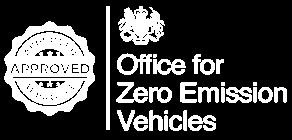

Ambition. Funding. Focus. Islington Council has all three and is on a journey to electrify its fleet. The council is in the process of reducing the size of its fleet and switching more vehicles to electric. To achieve this, they need robust EV charging infrastructure. Joju Charging is partnering with the council to drive this change
infrastructure upgrades will largely provide rapid and fast charging functions for council services, which are now on a renewable electricity tariff. The vehicle charging infrastructure Joju has installed, maximises charging at times of the day when renewable power is supplying a greater proportion of grid electricity. Vehicle batteries may also be used to help power council buildings during peak periods. These solutions will assist the electricity grid with the transition to a greater proportion of renewables. By pioneering in the UK with the scheduled installations, Islington is helping to create a greener future, and the new EV Charging Infrastructure has also meant financial savings have been achieved.
The pioneering infrastructure improvements that Joju are making are pivotal in Islington Council’s efforts to create a greener borough, where air quality is improved and where streets are more welcoming for all.
Let’s go back to June 2019. Islington Council declared a climate emergency and developed a comprehensive strategy to achieve net zero carbon status by 2030, with the aim of building a greener, healthier, more equal Islington. Primary focus areas include reducing air pollution, addressing the climate emergency, and reducing health disparities. With a resolute mission to protect the vulnerable and improve health and wellbeing within the community, Islington are working tirelessly to combat climate change. Creating a greener fleet is a key part of this.
The council’s electric fleet includes everything from cars and small vans, sweeping street vehicles, fully electric cage-tippers, and community transport buses, through to 26-tonne refuse collection vehicles. Joju Charging is designing and installing the necessary EV Charging Infrastructure to support them. AC and DC charging units are being installed across various council sites, exceeding expectations by completing the work in just over a year of project

managing the council’s infrastructure programme. The council has now tasked Joju with upgrading additional sites too.
Savings in the making
Islington’s fleet accounts for an estimated 2.3 per cent of transport CO2 emissions in the borough. By fully electrifying it, and by reducing the overall size of the fleet, the total reduction in CO2 is estimated at just under 3,000 tonnes per annum – equating to planting the equivalent of five football pitches of woodland in offsetting terms.
The various infrastructure upgrades Joju has carried out so far were designed to reduce CO2 emissions and local pollution levels of NOx, PM2.5 and PM10. Both NOx and particulate matter are major contributors to air pollution and can cause respiratory problems and other health issues, particularly in vulnerable populations. This is a key focus for the council.
With the very real climate emergency pressing, Islington has already taken great strides – introducing 80 full battery electric vehicles to the fleet and reducing emissions by around 300 tonnes per annum. The
As Tony Ralph, Islington Council’s director for environment and commercial operations, and Chris Demetriou, assistant director of corporate fleet and transport, put it: “Here in Islington, we’re determined to tackle the climate emergency, improve air quality, and create a more equal borough for all. Creating a smaller, greener fleet is vital in our efforts to make Islington a greener place, and our partnership with Joju is hugely valuable in helping us to transition to a more environmentally friendly fleet. Clearly, there is much more to be done as we work to tackle the climate emergency, and we look forward to working with Joju and other partners to achieve that.”
Joju Charging is proud to be supporting Islington Council with their pioneering project from an EV Charging Infrastructure perspective. If you would like our help to design and install the necessary infrastructure for your fleet electrification, please do get in touch with our head of EV charging, Graeme Patton. L
The electric vehicle charge point sector has grown massively over the last decade, but there are still some big obstacles to overcome to get the infrastructure we need. That’s why 22 of the major companies responsible for the UK’s charging infrastructure have come together to form ChargeUK. Ian Johnston, chair of the association, explains what they hope to achieve
One of the key shifts that needs to happen for the UK to reach its net zero goals is the transition to electric vehicles. But it’s not just about requiring manufacturers to produce EVs under a ZEV mandate, though that is a significant piece of the puzzle. No, the switch to electric also requires major investment in the public charging infrastructure so that driving an EV will be the best way to get around the UK.
Already, the industry has succeeded in placing the UK at the forefront of the global shift to electric vehicles and has solidified its place as one of the best places in the world to charge an EV, with over 44,000 public EV charging points.

The EV charge point sector has grown massively over the last decade, but there are still some big obstacles that we need to overcome in order to accelerate the rollout of the infrastructure we need. That’s why 22 of the major companies responsible for the UK’s charging infrastructure have come together this year to form ChargeUK.
At the time of our launch in April, we announced that our companies have committed over £6bn of investment in this critical infrastructure in the UK to 2030. Together, members of ChargeUK plan to double the number of charge points in the UK this year. And we’re already seeing evidence of the significant ramp-up in charge point
installations following the supply chain snags and general obstacles of the pandemic. And it can go even faster. As the voice of the UK’s EV charging industry, ChargeUK is committed to working with all levels of government to help remove barriers to deployment. We want to help resolve the issues around grid connections, planning permissions, and public funding processes. This is also why we need a strong ZEV mandate. Its strength will determine our confidence to invest in making the UK the best place to run and charge
an electric vehicle in the years to 2030. We also want charging EVs to be easy, reliable and accessible. The SMMT’s data on new car registrations in May 2023 revealed that EVs are more popular than ever – battery electric vehicle registrations have grown by 58.7 per cent year-on-year, now accounting for 17 per cent of the market share.
Drivers should be confident that there are enough chargers available and that they won’t be plagued with range anxiety every time they get on the road. Naysayers talk about low ratios of vehicles to chargers and highlight regional disparities – but this isn’t a helpful way to frame things. The number of public charge points isn’t a helpful metric because more than 80 per cent of EV drivers charge their vehicles at home or at work. As more drivers who don’t have access to off-street parking (i.e., who can’t charge in their driveways or while parked at the workplace) start
confidentshouldDriversbe that there are enough chargers and that they won’t have range anxiety every time they get on the road
making the inevitable switch, we’ll definitely need more converted lamp posts, roadside charging and service stations (and elsewhere). But I can guarantee you that they are already on the way.
The most recent figures from, Zapmap – the leading EV charging mapping service and independent authority on electric vehicle infrastructure – show that over 8,000 charge points have come online so far in 2023, with a string of record months for installations through the spring. This is an increase of 35 per cent since this time last year. The rate of charge point installations has increased significantly in 2023, with an average of 1,625 new chargers being installed each month compared to 914 per month across the same period in 2022 and 1115 per month across the whole of 2022.
There was also a significant increase in ultra rapid chargers, which can deliver a full charge in as little as 20 minutes. There are now nearly twice as many rapid and ultra rapid charge points available compared to this time last year.
There has also been a notable increase in both fast chargers, which are often found in car parks or destinations, and slower chargers, that are used in residential streets and workplaces.
According to recent figures, the new charger installation rate is up 75 per cent when comparing with the same period in 2022. These figures show the huge step-up in deployment of EV charging infrastructure that is underway in 2023, which will give further confidence to those considering making the switch to an electric vehicle.
The rate of deployment is increasing month-on-month but we can go much faster with the right policies and help from government to remove the barriers that are currently constraining the roll-out. Local authorities will play a key role in the rollout. We need more chargers where people have less access to off-street parking; in public places such as libraries and swimming pools and in tourist destinations across the UK.
In addition to pushing for a strong ZEV mandate and removing barriers to installation, ChargeUK has identified four other priority areas: the consumer experience and accessibility; the Rapid Charging Fund; the inclusion of electricity in the Renewable Transport Fuel Obligation; and equalising VAT on public and private charging. All of these priorities are crucial pieces of the EV transition puzzle, and tackling them will enable the EV charging industry to further quicken the pace of deployment. Alongside these focus areas, we recognise that accessibility and equality remain fundamental building blocks in the fight for Net Zero. Hence, we want to see VAT cut on public charging so that it matches the rate paid by those who are able to charge their EV at home. Currently VAT is 20 per cent on public charging points, as opposed to only five per cent at home, which clearly disadvantages those who are unable to have a charging point at home. Equalising VAT rates is a fairly low cost policy but one that would send a huge message as well as addressing an obvious unfairness.
In order to accelerate the increase in the number of EVs in the UK we need to ensure accessibility and equality regarding their charging points. ChargeUK will continue to work collaboratively with charging operators, consumer groups, and other campaigners to further this important initiative.
We’re thrilled that our industry has now matured to this point. Now it’s time to go further and faster in the race towards net zero. With billions of pounds of investment behind us, we see nothing but opportunity – for job creation, for innovation and for creative solutions.
It’s an exciting time in an exciting industry. ChargeUK members can be proud of what we’ve achieved so far, and of what we are achieving right now and we have much to look forward to in the years ahead.
The EV transition is a crucial pillar for achieving Net Zero, and we’re committed to making it a reality. L
Ian Johnston is the chair of ChargeUK, the trade association representing the electric vehicle charging infrastructure industry. He is CEO of Osprey Charging Network.
FURTHER INFORMATION
To learn more about ChargeUK visit chargeuk.org, or follow them on Twitter (@ChargeUK_) and LinkedIn.

ElectriX offers a wide range of cars to lease (personal, business and salary sacrifice), with many cars available within as little as 30 days, as well as home charging and bespoke electric car insurance.

Powered by LV= General Insurance, ElectriX offers one of the most flexible electric car salary schemes on the market –with no upfront costs to you or your employees, giving your team the opportunity to lease a brand-new electric vehicle (EV) for up to 40 per cent less and with zero hassle.
We help you decide whether an electric car is right for you, what it costs to own and run one, and how to charge – both at home and on the road.
From finding the right car through vehicle leasing experts CBVC, providing a smart home charging solution via leading provider Indra, and offering bespoke insurance as well as useful guidance and advice, ElectriX is designed to give drivers the confidence to drive electric cars.
As far as your staff are concerned, it’s an employee benefit. The lease fee is deducted at source from the employee’s gross salary, which means they pay less tax overall. Though they are liable for a small amount of Benefit-in-Kind (BIK) tax which until 2025 stands at two per cent, in comparison to certain diesel cars at up to 37 per cent. If they leave the company, they simply hand the car back to you, with certain conditions attached.
All they’ll have to do is take care of the charging at home or at one of the 44,000 public charge points around the country.
As an employer, you can save on National Insurance on the amount sacrificed by the employee. You can lease as many cars as you need. Hiring a fleet of electric vehicles will have a considerable positive impact on your company’s sustainability profile. L
www.LVelectriX.co.uk

Reduce your NI contributions
Retain and attract talent
Help meet sustainability targets
Find out more
Powered by LV= General Insurance, ElectriX offers one of the most flexible electric car salary sacrifice schemes on the market, with a flexible range of risk protection options should people leave
vehicles to its employees will be perceived by them to be progressive and forwardthinking, and a desirable team to be a part of.
Powered by LV= General Insurance, ElectriX offers one of the most flexible electric car salary sacrifice schemes on the market.
We’ve created an attractive scheme designed to benefit both employers and employees. Your team will love our all-inclusive electric car options with no upfront costs – saving them thousands. And to safeguard your business, uniquely we offer the most flexible range of risk protection options in the UK should people leave.
An exciting opportunity

Go the extra mile and deliver real company benefits, give your team the opportunity to drive a brand-new electric car with savings of up to 40 per cent off the price of a lease car. We’ve got home charging with Indra, and insurance through Flow, all wrapped up and included in the package. Goes without saying that servicing, maintenance and breakdown come as standard too for an “effort -free” electric vehicle experience.
At no cost to your organisation EV salary sacrifice provides a host of benefits. These include attracting and retaining talent, reducing your national insurance contributions, and supporting your sustainability targets. It’s free to set up and with ElectriX, we promote and set the scheme up for you. Want to know more, why not enquire on our website here, and you could be up and running in just a few weeks.
Employees are increasingly looking for more than a good salary, expecting companies to provide them with a range of benefits that go beyond standard ones such as medical care. A company that offers electric
Introducing your team to EV salary sacrifice is a great way to save your team up to 40 per cent on a brand-new electric car lease. Help improve your employee retention rates and attract new talent, all while meeting your sustainability goals. The scheme is free to join and easy to set up and comes with the most flexible range of risk protection options in the UK should people leave.
As an employer, you can save 13.8 per cent on National Insurance on the amount sacrificed by the employee, while they stand to save a considerable amount on tax. It’s an attractive proposition for employees at all levels, especially those in higher tax brackets.
Employees who use an electric car salary sacrifice scheme will have to pay Benefit in Kind (BIK) tax. The government has confirmed BIK will remain at two per cent for zeroemission cars until 2025, after which it will rise by a maximum of just one per cent per year until 2028, when it will be reviewed.
With the monthly leasing fee coming out of an employee’s gross salary, their tax bill will be lower, resulting in tax savings of up to 40 per cent depending on their tax bracket.
As an example of the savings to be made under the scheme, a 20 per cent taxpayer can get an MG4 Hatchback EV from ElectriX and CBVC for a monthly gross salary sacrifice of £491, but this only reduces their net salary by £346. Over a four-year contract, £68 a month can be saved by the employer, taking into account BIK tax.

Surveys have repeatedly shown that the majority of employees in the UK would like to benefit from some sort of salary sacrifice arrangement. If the company you work for already has such a scheme, you probably know about it and are already taking advantage of it. If it doesn’t, why not talk to your staff about introducing one, to join the growing number of companies taking part.
Leasing an EV through a Salary Sacrifice scheme enables employees to make significant cost savings. Starting with overcoming the high initial upfront costs associated with EV ownership. Your team can benefit from Reduced income tax and National Insurance contributions - lease payments are deducted from pre-tax income, resulting in lower taxable income and potential savings.
There is added comfort of 100% exemption from ULEZ and clean air zone charges, along with lower running costs compared to traditional petrol and diesel cars, savings on maintenance costs and reduced depreciation. There are no upfront costs and flexible solutions if they leave during the course of the contract.
As an employer, you could also take advantage of tax incentives and reduced employer National Insurance contributions. The scheme is Free and simple set up – you can offer an ElectriX EV Salary Sacrifice scheme to your employees and it won’t cost you a penny.
ElectriX have a best in market tailored approach to risk with the most flexible range of protection options should employees leave during the course of the contract. L


ENTRIES OPEN
TELL US ABOUT YOUR FLEET SUCCESSES

British Motor Museum, Gaydon
Thursday 7th December
RECOGNISING CLEAN FLEET INNOVATION ENTER
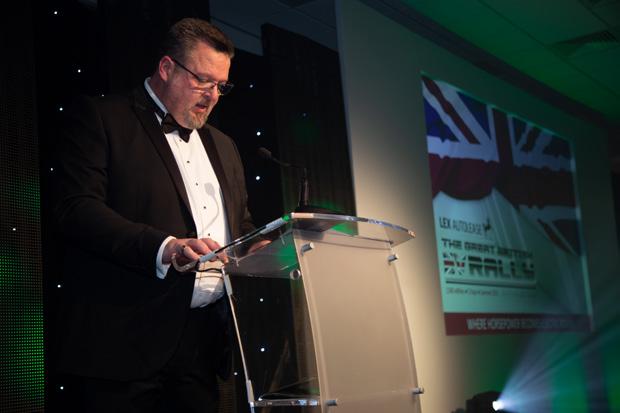
North Tyneside Council’s Killingworth site depot is the scene of a new energy eco-system, which uses a solar PV array, battery energy storage system, and chargepoints to support its electric fleet. We speak to Ian Lillie, the Council’s strategic facilities manager, for more details on the project
North Tyneside Council has embarked on a project to futureproof its Killingworth Site depot for sustainability and energy efficiency.

The depot – which is home to around 1,000 council staff and partners – now includes a solar PV array and car ports delivering 700 kilowatts at peak generating around 600,00kW/h of electricity per annum.
What’s more, batteries taken from end-of-life electric vehicles are repurposed as a battery energy storage system (BESS) to support the council’s EV fleet. The BESS collects and stores the excess solar energy, which allows the council to charge its EV fleet at night through its newly installed chargepoints.
Ian Lillie, strategic facilities manager for North Tyneside Council, explains more about the project.
Firstly, please could you give us an overview of the EV charging project you have completed at your Killingworth depot?
The EV chargepoint installation is part of a multimillion-pound council investment to refurbish its main operational depot in Killingworth. This refurbishment was supported with grant funding from the European Regional Development Fund which allowed a number of energy efficiency, generation and storage initiatives including solar PV, battery storage, LED lighting and EV charging.
Why was it decided to approach EV charging in this way and what challenges does it address?
We approached the installation of the EV charging as an integral part of the micro-grid element of the project which aims to deliver optimum energy demand, generation, and storage solutions. The project addresses space underutilisation, energy efficiency and the need to create infrastructure to align to council policy and our net zero ambitions.
The project has delivered 66 charge points in total with a number of these for dedicated use by the council electric operational fleet vehicles, which to this point were being charged through mains three-pin sockets.
It’s an innovative project involving many different organisations – what were the challenges whilst setting up the project?
The project offered many challenges. First and foremost, the site is a live operational
depot and all works had to be undertaken to mitigate impact on service delivery.
The site also consists of two Grade 2 listed buildings and was also supported by ERDF grant funding. It was keenly and robustly overseen by the council’s elected mayor and senior leadership team and has delivered improved working conditions for around 1,000 council and partner staff.
The substantive part of the project was also delivered during the covid 19 pandemic which stretched the project delivery chain on many fronts.
Are you realising any cost and CO2 savings yet – or what are these predicted to be?

We have begun to measure the various cashable and non-cashable savings and overall, the project has reduced the council’s energy demand from the grid by around 2.5Million Kw/h and will result in CO2 savings of around 700t. The EV charge points have only been live for around a week [at the time of writing] and so far, they have offset CO2 equivalent to 18 trees being planted and over 1,000 plane miles.
What advice would you give to other public sector organisations looking to set up a similar EV charging system?
Speak to organisations who have delivered similar schemes and wherever possible consider EV charging in parallel with Solar PV and Battery Storage. Be strong on your specification and know your market. L
my.northtyneside.gov.uk
takenBatteriesfrom areelectricend-of-lifevehicles repurposed as a battery energy storage system
Rising costs, and the increasing complexities of operating a car and light commercial vehicle fleet, have led to many companies placing their vehicles and drivers in the hands of a fleet management specialist.

Interactive Fleet Management is The Grosvenor Group’s dedicated fleet management team with over 40 years’ expertise in driving down costs and keeping drivers mobile.


Whether you own your vehicles, or contract hire them, we can become an extension of

Interested to know how much we could save you? Or, how a fleet management solution could work for your business?
your fleet department – offering a service tailored to your requirements.






All customers benefit from OSCAR365, our award-winning fleet management system, and our innovative driver App, OSCAR Go, gives drivers easy access to all aspects of support.
It’s all part of a streamlined, efficient solution that will drive down your operational costs and save you time.









There are four key challenges facing fleet operators, and as these intensify, many fleet managers are looking for external support
“The true benefit, however, is the specialist expertise you enjoy with the software as an Interactive Fleet Management customer. For a very similar cost to leasing fleet software, we offer a fully managed service giving our customers the best of both worlds.”
In fourth place is compliance. The complexities of operating a fleet amidst intensifying health and safety legislation has added to the pressure fleet managers are under.
Companies operating fleets of cars and light commercial vehicles are increasingly turning to specialist fleet management providers, as the challenges of operating a vehicle fleet intensify.
According to Andy Reed, operations director at Interactive Fleet Management, there are four key challenges facing fleet operators, causing many fleet managers to look for external support.

Cost control is the main one. With interest rates soaring, and the cost of running a vehicle fleet rising dramatically, many companies are looking at how they can tighten up on their finances and implement measures for reducing costs and improving budgeting.
Second is the electrification of cars and light commercial vehicles. Many businesses are recognising that transitioning to EVs can be a delicate and complex process of change.
For car fleets it is important to develop vehicle choice policies using whole life costs to demonstrate the financial benefits of moving to an all-electric fleet, based on total cost of ownership.
Encouraging drivers into electric cars also means ensuring that the vehicles suit their job role and lifestyle, as well as ensuring drivers feel fully supported in areas such as vehicle charging (and installing home chargers where possible), EV servicing, maintenance and repair, and driver education regarding moving away from their tried and trusted petrol or diesel.
For commercial vehicle operators, the move to electric vehicles is even more complex, with many companies struggling to see how electric vans can fulfil their business commitments.
Those leading the way with electrification are no longer looking to see how EVs
can fit in with their current operating model, and are instead reviewing their whole operation to see how it may need to adapt to electric vehicles.
“The challenge for van operators is a really significant one,” said Andy, “and we have recently conducted a round table panel with our commercial vehicle customers to hear first hand the challenges they face.
“What’s clear is that Board level buy-in is vital. The shift to electric LCVs must be driven from the top to give it true momentum across the business as this cannot be left as a task solely for the fleet team. The impact spans operations, finance, recruitment, training and estates planning.
“Those companies who are well down the road with electrifying their commercial vehicles have had a complete rethink of how the previous diesel fleet has traditionally supported the business’ objectives and taken a fresh look at how the business will look with a fleet that’s electric.”
Thirdly comes software. Fleet software, and the digitising of vehicle and driver processes is very high on everyone’s agendas.
“Huge efficiencies can be gained through integrated software solutions and Apps,” continued Andy, “and, very often, we are talking to fleet managers who were initially looking for a standalone fleet management system for their business, but realise that they would be far better off, not just with the software but a team of fleet and maintenance professionals to manage it for them.
“At Interactive Fleet Management, OSCAR 365 – our award-winning fleet management system, and OSCAR Go –our driver App, are market leading in our sector and have been developed for over a decade by our in-house software team.
The legal obligations are complex, and many fleet managers do not have the time to fully educate themselves in all aspects of compliance or how to manage it.
Further still, drivers understandably want to be assured that their employer is doing everything it can to ensure they are safe, legal and compliant while out on the road.
“Never before has operating a vehicle fleet been more challenging,” said Andy, “and it’s for this reason why many fleet managers are looking to bolster their team by using our specialist fleet management solution as an extension to their fleet department.
“In many cases, the drivers may not even realise which aspects of support are being provided by us as an outsourced provider as we place all vehicles and drivers on our fleet management platform, we answer the phone in their company name and we integrate seamlessly into the customer’s fleet team.
“Due to the breadth of offering across the Grosvenor Group, Interactive Fleet Management customers can also enjoy further savings through our electric vehicle salary sacrifice scheme, personal leasing, short term rental and a complete portfolio of solutions, all managed under one roof.” L

Vehicle electrification will no doubt be in the minds of fleet operators, as the 2030 end-date for new petrol and diesel vehicles comes closer. With around 80 electric models available, attention has now turned to how these vehicles will be charged. We ask our expert panelists to discuss all things charging infrastructure – from workplace, home and public charging, to ensure any charging strategy is successful

Alun Davies is the operations director of ElectrAssure Ltd and was proud to receive the EV Champion award at the Greenfleet Awards 2019. With 10 years’ experience in EV charging, Alun is responsible of the day to day running of ElectrAssure and is the first point of contact for customers, suppliers and staff while continuing to lead the electrical teams from a technical standpoint. Alun is a City & Guilds qualified electrotechnical engineer with 18th edition wiring regulations and EV charger installation qualifications and several expert installer certificates.

Dan has a decade of experience in a number of different areas within the EV sector. Prior to joining Drax, he worked in sales for a charging solutions company focussing on smart technologies. Prior to that, he spent time working in sales and business development for a provider of EV charge points. Dan’s role at Drax is to work with customers on end-to-end electric vehicle business charging solutions that enable financial and sustainability benefits to their business.

Gill has over 20 years’ experience across sustainable energy, utility, and environmental technologies sectors, including eight years working on electric vehicle-grid integration projects (My Electric Avenue, Smart EV, Electric Nation). Gill initiated the establishment of the EV Network Group, that transformed into the Governmentsupported EV Energy Taskforce, and co-founded EVA England in 2020. She is now Head of EV Communications at LV= General Insurance, working on its new EV proposition ElectriX.
The 2030 ban on new petrol and diesel vehicles has focused the attention of vehicle manufacturers, and there are now around 80 electric models available across every vehicle segment. Companies considering their fleet strategies will no doubt be preparing for the change – and many will already be making progress in switching their vehicles to zero-emission alternatives. But such a substantial change to established practices take careful consideration, and there are a number of things to think about before embarking on fleet electrification. One of the main areas to consider is how the vehicles will be charged.
“Successful electrification of fleets relies on a thorough assessment of fleet behaviour to ensure that the transition will be smooth and meet minimal
resistance,” comments Alun Davies, operations director of ElectrAssure.
“Driver mileage and behaviour must be assessed in order to understand whether the electric vehicles are able to cover the mileage required by the operators usual driving patterns and whether adequate dwell time to charge the vehicle is available either in the working day or between shifts. If the driver mileage is lower than the expected EV range, then the assessment of when and where the vehicle is stationary and for how long will begin to form the basis for the charging provisions required as they will need to be adequately charged within that time frame.
“Charging is always best, where possible, provided at company or driver premises to avoid any delays or issues that can be encountered when using public charging.
However, the increase of available and reliable public charging means that in exceptional circumstances, such as longer than average journeys, drivers are able to make it to their destination. Utilising home and public charging as part of the plan for charging fleets isn’t uncommon, however, it is critical that the payment for public charging or the reimbursement of home charging activities is simple and as close to autonomous as possible to prevent resistance from drivers.”
Daniel Eyers, electric vehicle charging specialist for fleets at Drax, breaks down the areas of fleet electrification into three categories –range, cost and infrastructure. He says: “Fleet managers will need to take vehicle range into account if their EVs are travelling hundreds
of miles each day. As they’ll be aware, drivers stopping to charge their vehicles can cause operational inefficiencies. Planning charging solutions will be more complicated if the fleet’s EVs have high mileage requirements.”
Fleet managers will need to project the costs of charging based on the options available and the specification of their fleet. Daniel Eyers comments: “Buying charging hardware and installing it on company sites carries a high upfront cost – but it brings down the ongoing cost of charging. Drivers will know where to charge and can avoid high public-chargingfacility prices. There may also be the option of recouping some of the initial expense by introducing charging tariffs for visitors.
“It’s also worth noting that government support exists for the upfront cost of purchase and install. And organisations shouldn’t assume they always need the most powerful chargers. Low-power units are often sufficient if charging vehicles overnight – and they’re much cheaper.
“Leasing the hardware is also an option –particularly if the organisation doesn’t own the site or may be looking to move in the future.”
There is also the option of installing home chargers in drivers homes, and of using the public charging infrastructure. Dan Eyers comments: “Installing chargers at drivers’ homes can be complicated, but it can also increase operational efficiencies and minimise ongoing charging costs. As well as reducing the need to charge at expensive publiccharging facilities, it’ll enable drivers to charge overnight, when electricity’s at its cheapest.
“Relying on public facilities means paying over the odds for charging EVs –but it avoids the upfront cost of buying (or leasing) and installing a network of chargers. Organisation’s should consider their needs and compare the cost implications of suitable charging solutions.

“To help with this, Drax partners with Mina to offer its Homecharge and Chargepass solutions. Homecharge accurately pays drivers’ domestic energy suppliers each month for the cost of charging their company EV at home. Chargepass provides access
to over 11,500 public-facing charge points via drivers’ fuel cards and issues a monthly invoice directly to the organisation.”
A good understanding of drivers and vehicle requirements is needed for an informed transition to electric vehicles, believes Gill Nowell, head of EV communications at LV= General Insurance and ElectriX. She says: “Clear communication with employees who will be driving electric vehicles is key; understanding what kind of mileage they’ll be doing, and where and how they will charge is critical.
“It will be important to consider whether installing chargers in the workplace is an option, or whether drivers will be able to charge at home. And indeed what local and en-route charging facilities are available – we now have over 45,000 public chargers across the UK, so there are plenty of options to choose from!
“If we focus on workplace charging for a moment, there’s a government grant available, run by the OZEV and administered by the Driver and Vehicle Licensing Agency (DVLA). The grant covers up to 75 per cent of the total costs of the purchase and installation of EV chargepoints (inclusive of VAT), capped at a maximum of £350 per socket, and 40 sockets across all sites per applicant.”
So if workplace charging is decided upon, what are the key steps to consider to ensure success?
Alun Davies from ElectrAssure, says that the first consideration is to assess whether the site has parking spaces for charging. He comments: “To avoid an almighty game of
vehicle tetris, suitable parking spaces will make installation and consequent utilisation of the chargers simple and efficient.”
Then there’s power capacity, driver dwell time and future proofing. Alun Davies explains: “Charging requires power. Simply put, without adequate available electrical capacity, efficient charging at the speeds required will not be possible.
“Regarding driver dwell time, assessing the amount of time drivers are stationary from a vehicle perspective at a given site or premises will guide the provision of charging provided due to the timeframe within which they require to be charged in order to avoid delays.
“Finally, while assessing current or shortterm fleet charging requirements is critical, assessing future requirements is just as important. Installations can be expensive and by carrying out the enabling works (installation of supply & civils works) for future requirements at the initial installation stage, expensive upgrade works can be avoided.”
Define the steps involved
Daniel Eyers from Drax says that it’s crucial organisations list and review the steps involved with installing fleet charging infrastructure. “Doing so will help them establish whether they feel confident managing the process themselves – or if a contracting an electrification partner to provide expert end-to-end support would be preferable,” explains Daniel. To start off, an organisation needs to do an EV suitability assessment. Daniel Eyers explains: “An assessment of an organisation’s existing fleet and its operational requirements is a vital initial step before committing to purchase or install hardware. Understanding existing vehicle operational requirements E
Without adequate available electrical capacity, efficient charging at the speeds required will not be possible
Many cars available within
30 days
Low Benefit in Kind rates
Employees can save up to 40% on the cost of an EV lease

Find out more

via telematics or manual tracking will enable organisations to, for example, define average and maximum daily mileage requirements, by vehicle, to help them understand whether EVs will be able to carry out daily business requirements on a single charge. If they can’t, the organisation will know it has to make additional charging provisions or operational sacrifices.
“Fleet managers should appreciate geographical travel spread, by vehicle. Knowing where a vehicle needs to drive each day will offer insights into suitable charging locations.
“They should also identify popular EV ‘dwell’ locations – where vehicles aren’t in use for long periods, to establish where they could be charging without affecting operations. Examples might include depots, offices or drivers’ homes. Long dwell times – particularly if overnight – can offer operational efficiencies and savings through access to off-peak electricity prices.”
Once organisations have established optimum charging facility locations, a detailed site survey will be needed. Daniel Eyers explains: “A site survey will show a sites’ electrical capacities, the likelihood of needing to extend electrical capacity via Distribution Network Operator, and hardware electrical connection practicalities. Results of the electrical site survey will also lay the foundation for planning installation logistics.”
Following this, scheduling and preparing for the installation of charging hardware is required. Daniel Eyers expands: “Installation planning will allow organisations to plan timing to minimise disruption on site and to business as usual, and to coordinate hardware deliveries to avoid delays/conflicts with labour.
“It’s wise to ensure necessary specialists are available to manage installation; carry out groundworks; make electrical connections, test/commission, and to educate drivers and site management. Organisations must also ensure there’s a clear point of contact for all implementation works.”
“Other considerations include approvals – whether the organisation will need sign-off from the landlord or senior management – and the possibility of powering the hardware through renewable energy generation assets,” Daniel adds.
EV salary sacrifice
Regarding the electric vehicles themselves, there are various options that organisations can take to access them in a flexible and costeffective way. Electric vehicle salary sacrifice schemes, for example, can help companies support their employees to go electric.

Gill Nowell from ElectriX, explains: “General salary sacrifice schemes are now adopted by over 60 per cent of UK businesses with perks ranging from childcare to gym memberships. Salary sacrifice is basically where employees voluntarily give up a portion of their salary in return for a benefit. It’s no surprise then, that EV salary sacrifice works in exactly the same way, offering an affordable way to switch to electric with savings of up to 40 per cent plus associated low running costs, environmental benefits through helping to

improve local air quality, and further cost savings through exemption from London’s ULEZ and clean air zone charges.
“Electric vehicle salary sacrifice schemes are also proven to help attract and retain talent; sustainability is a big part of our lives and the choices that we make. A recent survey showed that 83 per cent of employees would have greater loyalty to an organisation that helps them contribute to their sustainability goals, and indeed the Companies Act 2006 requires large and medium-sized companies to report on the business’s environmental impact on an annual basis. By implementing an electric vehicle salary sacrifice scheme, a business can align itself with environmental goals, demonstrate corporate social responsibility and enhance its reputation among employees, customers, stakeholders and the wider community. Encouraging employees to opt for electric vehicles means your business is actively contributing to reducing carbon emissions, cutting noise pollution and combatting climate change. So it’s a win-win! E

“ElectriX offers EV salary sacrifice – we provide an all-inclusive package of electric car, home charger and insurance. Through lease specialists CBVC we offer over 100 electric car models from more than 30 manufacturers – many available within just 30 days. Through our partner Indra we provide smart home chargers to energise every journey, and we provide bespoke insurance through Flow, our digital sister company. With our best in market tailored approach to risk, we can also safeguard your business with the most flexible range of protection options should employees leave.”
Smart charging
Smart charging regulations came into force in June 2022 and state that charge points must have smart functionality, allowing the charging of an electric vehicle when there is less demand on the grid, or when more renewable electricity is available. So why is it important?
Alun Davies from ElectrAssure explains: “Smart functionality is something we are all accustomed to in our day to day lives; smart phones, smart technology etc. Smart functionality in chargers is no different. It allows the phone to connect to a cloud based management system to both report its behaviour and also receive commands.
“As part of the Smart Charging Legislation, chargers must be able to delay commencing charging, be able to have their charging rate increased or decreased via the management system and to be able to be accessed by an app or web portal. These mandatory requirements are designed to ensure that chargers are user friendly, reportable and are able to respond to grid or local power constraints. It is also designed to allow users to limit charging within certain time windows to make use of off-peak electrical tariffs at a cheaper rate.”
Daniel Eyers from Drax adds: “Put simply, charge stations are either ‘smart’ or ‘dumb’. Dumb chargers are only capable of providing electrical charge to an EV – they’re little more than a glorified plug socket.
“Smart chargers offer more functionality to organisations and drivers. This can include cheaper tariffs, restricting access, data insights and the ability to remotely start or stop charging sessions, for example.
“Additionally, smart chargers help optimise efficiencies via load balancing. Organisations can, for example, decide whether they’d prefer to charge one EV at full power or three different vehicles each at one-third power. Smart chargers can also help to protect vehicles’ batteries by charging them at a rate which doesn’t cause damage.
“As well as helping organisations maximise the effectiveness of their investment, smart chargers can help the National Grid cope with peaks in energy demand.”
Gill Nowell from ElectriX, believes that smart charging is a good and necessary feature, and was involved in some smart charging trials in the early days.
Gill says: “A smart charger is essentially one which can be remotely managed, if necessary, to manage any potential impact on the local electricity network. The requirement for EV chargers to be smart is basically there to protect you and I as electricity customers – to help prevent the lights going out – with the added benefit of low-cost charging thanks to EV-friendly off-peak energy tariffs.”
“The Distribution Network Operators have been working ahead of need to manage EV uptake on their energy networks since 2012 – and smart charging has come about largely as a result of all that work and learning.”

Speaking about her experience in charging trials, Gill Nowell comments: “I was involved in a number of real-world trials involving hundreds of early EV drivers to understand the impact of clusters of EVs charging on the Low Voltage network (e.g. My Electric Avenue 2012 – 2015, Electric Nation, 2016 – 2018). We learnt so much about driving and charging behaviour, and whether EV drivers would accept having their charging managed - in order to protect the network and avoid costly reinforcement that would potentially mean bills going up.
“By having a smart charger installed at home – I have an Indra Smart Home PRO – I can schedule my charging using an app, so that my car only charges during off-peak hours when electricity is cheapest and greenest. Thanks to smart charging, it costs me less than £5 to fully charge my Kia e-Niro, so that’s 280 miles for under a fiver.”
Gill Nowell shares further details of smart charging: “Every new charger from July 2022 must be set to default off-peak charging hours, although the user or owner can still
override this feature if needed despite the off-peak setting. Also, smart charge points must have a randomised delayed charging ability of about 10 minutes – which means that charging may be delayed either at the start or end of the charging session. This feature helps to protect the Low Voltage network from any surges in demand. And again, it can be overridden if needs be.
“So in summary, smart charging is there to protect the local electricity network, to avoid costly network reinforcement – or at least enable a planned and managed approach to network upgrades, and it means that us EV drivers can benefit from really low off-peak energy tariffs, making charging at home really cheap and convenient. Smart charging is a good thing.”
The government is aiming for 300,000 public chargers to be available by 2030. And alongside an increase in the amount of charging provision, new draft charge point regulations have come out which, when they come into force, will help iron out the issues felt by users, such as differing payment requirements.
So is the government’s goal realistic?
Alun Davies from ElectrAssure gives his views: “300,000 public chargers is a lot. At the time of writing, approximately 60,000 are currently installed and while this number is growing all the time due to more EVs on the road and therefore greater utilisation, there will need to be a huge increase in new charging installations to achieve this number.
“However, with EVs making up 16 per cent of new vehicle purchases last year, the E
force in June 2022 and state that charge points must have smart functionality, allowing the charging of an electric vehicle when there is less demand on the grid, or when more renewable electricity is available
When you are operating critical services, you need a safe pair of hands.

When you rely on your electric vehicles for your business, downtime simply isn’t an option. Our clients value us because we refuse to let them down.
Contact us today for an initial, no-obligation audit by our team of specialist electrical engineers. We promise: no slip-ups.

need for these chargers is clear and as such, the business case to provide more public charging is becoming stronger and the return on investment is higher.
“But hurdles exist for public charging providers to carry out these installations. Planning permission, financial constraints, new DNO connections and availability of chargers being produced from the manufacturers mean that the amount of charging infrastructure required within the relatively short time frame simply may not be possible. However, the provision of more reliable public chargers for the UK’s EV drivers is more important than ever but the target set may just be a little too ambitious.”
Daniel Eyers adds: “Progress to date would suggest otherwise, but the 300,000 target’s still possible by 2030. Both the government and organisations need to commit in order to achieve it.
“Certain organisations, including destinations such as supermarkets and shopping centres, can contribute to the total number of public chargers themselves – and benefit financially. Additionally, the number of public charge points may not need to be as high if organisations and the public invest

in their own facilities. This will ease the strain on the public charging infrastructure.”
But with many organisations choosing to ‘watch and learn’ from the experiences of others, this could lead to slow adoption.
“Other barriers include upfront cost, strict planning regulations, a locations’ electrical capacity limitations, and the impact of increased energy demand on the National Grid,” adds Daniel.
Getting the infrastructure right Gill Nowell comments that while the number of chargepoints is important, they also need to be the right speed, in the right locations, functional, accessible and easy to use. Gill says: “The good news is that government is implementing a series of improvements to public charging under the Public Charge Point Regulations 2023, covering reliability – on average a 99 per cent rate of reliability must be maintained (although only applies to chargers above 50kW), enforcing a 24/7 helpline, and pricing must be transparent –so you know what you’ve paid! Contactless payment must also be available – on new chargers above 8kW and existing rapid chargers above 50kW. It also supports
open data and promotes interoperability and payment roaming services.”
Industry is making significant progress, and a new trade association has been set with a commitment to increase chargepoints, and to lobby government for change that the industry needs to accelerate progress.
Gill explains: “A new trade body called ChargeUK has recently launched, whose members comprise of the vast majority of UK CPOs, headed up by Osprey’s Ian Johnston. They are committed to doubling the number of public chargers in a very short space of time, notwithstanding issues around cost and complexity of grid connections.
“And therein lies the key issue in charging infrastructure roll-out – the cost, time and complexity of grid connections. But I believe this is high up on the list of concerns that ChargeUK are lobbying on.”

Pointing out the other charging options and solutions out there, the public charging infrastructure may not be used as much as people think. Gill says: “There is understandably a lot of focus on public charging infrastructure – however most EV drivers today do most of their charging at home. There are over 400k home and workplace chargers, and for those people who can’t charge at home, an increasing number of on-street or lamppost chargers, and other solutions such as charging cable gullies through the pavement – those solutions have the added benefit of being far cheaper than using public chargers, given that the rate of VAT on domestic electricity is only five per cent, whereas it’s 20 per cent on public charging.
“Overall the EV charging infrastructure is making great progress. And once you’re driving electric, it’s hard, if not impossible, to go back to anything else,” Gill adds. L
FURTHER INFORMATION
leasing.lvelectrix.co.uk energy.drax.com www.electrassure.co.uk
Start your all-electric future now. We are ready to guide you through the transition to zero-emission transport. DAF can recommend and deliver the optimum truck configuration and charging strategy for your business. Plus, our trusted dealer network offers the facilities, expert advice and a dedicated driver training programme, ensuring you gain the maximum potential from your electric operation. DAF.COM/DAF-ELECTRIC

After being named the media industry’s ‘Event of the Year’ in 2022, the EV Rally pushed the boundaries even further this year, with a more challenging route, a more diverse mix of vehicle sizes, and more participants – all with the aim of testing how electric vehicles and public charging infrastructure measure up. So how did the teams get on?
Covering a challenging route of over 1,200 miles and visiting all the capital cities of the UK and Ireland, the 2023 EV Rally, sponsored by Lex Autolease, was a real-life test of how electric vehicles and the public charging infrastructure measure-up in the real world.

With the 2030 ban on new petrol and diesel vehicles fast approaching, there are now around 80 electric models available across every vehicle segment – compared with just 21 in 2018, according to the SMMT. And according to Zapmap, there were 44,408 electric vehicle charging points across the UK at the end of June 2023. Yet an anti-EV rhetoric lingers, with headlines saying the public charging infrastructure is not up to scratch, and recently, there has even been unrest over environmental targets and clean air measures.
The aim of the rally, which took place 3-7 July, was to test how electric vehicles perform on a long and challenging route, using the public charging infrastructure. It was also to highlight the areas for improvement in the infrastructure, and this year, with the inclusion of two electric trucks, to see how the charging network performed for heavy-duty vehicles.

For the first time, the EV Rally travelled over to Ireland, which has far less chargepoints than the rest of the UK, to see how teams would get on.
As with previous years, the rally was made possible thanks to the collaboration
between the organisers, teams and partners – made up of charging providers, vehicle manufacturers, fleet operators, breakdown providers, telematics companies, host authorities, and many more.
The EV Rally covered over 1,200 miles, with teams travelling from the start line in Cardiff, then going to London, Edinburgh, Belfast, and Dublin – with designated
checkpoints at clean energy projects, iconic sites and charging hubs on route. The first day of the Rally saw teams gather at Cardiff Bay Barrage, where Caro Wild, Cabinet Member for Climate Change at Cardiff City Council, waved teams off from the start line. The convoy then headed to the first check point in Bristol, where headline sponsors Lex Autolease held an EV showcase at the Amphitheatre, supported by Bristol City Leap and Bristol City Council. E

Teams then travelled to Heathrow to visit the Hertz electric rental site. The next checkpoint was at OVO Wembley Arena where teams received a joyful welcome from the OVO Energy cheer-leaders. Checkpoint four took place at bp pulse’s EV hub in Kettering, where vehicles could charge on one of their ten 300kWh units. The Rally then made its way to the final checkpoint of the day at Leicester Tigers stadium for the Europcar showcase, in the shadow on the new Europcar West Stand. Teams finished the day at Nottingham where they were able to charge overnight at Nottingham City Council’s innovative charging facilities.
All-electric miles
Day two of the Rally covered 316-miles, making it the longest day. Heading off from Nottingham, the teams visited York’s hyper hubs for the Churchill, Maxus
and Speedy showcases. Checkpoint two was at Washington where the Rally’s Charge Card Partner, Paua, showcased its product at the Fastned hub. Team DPD then presented on its progress in fleet electrification at its neighbouring NE depot.
The Rally then visited ORE Catapult, the UK’s leading technology innovation and research centre for offshore renewable energy, before heading to the England-Scotland border, where teams put two wheels in each country. Day two ended in Edinburgh at East Lothian Council’s Wallyford hub.
On day three, the Rally left Edinburgh and headed to Kilmarnock for a charge at the innovative Hub at the Athletics Stadium, before making its way to Cairnryan/Stranraer to hop on the Stena ferry to Belfast.
Day three ended at an event called EV Rally LIVE!, which took place at Titanic Belfast. This allowed teams to network with a gathering of
Belfast EV dealerships, as well as hear about the innovation taking place from teams Mercedes-Benz Trucks, Drivetech, AA, DAF-Cenex, Webfleet, and Black Horse. Kempower was the Official Charging Partner for EV Rally LIVE! and brought with them the innovative ‘Movable DC’ unit for drivers to get charged up for day four.
Thursday was ‘Game of Thrones Day’, with the Rally visiting two filming locations from the iconic series – Ballintoy, the scene for Pyke, The Iron Islands, and Ballimoney, the Dark Hedges used to shoot the ‘King’s Road’.

Other day four checkpoints included Cloughmills, a new Weev mini-hub showcased at the McGuckian Milling Company, the Giants Causeway, the most visited tourist spot in Northern Ireland, the Battery Bar on the banks of Lough Neagh, and the beautiful town of Newry. During their time in Northern Ireland, teams had access to the Weev charging network.
The final day of the 2023 EV Rally saw participants take in the beauty of Ireland, with innovation and clean energy projects as checkpoints.

EasyGo was the Rally’s Charging Partner for the Republic of Ireland and gave teams access to 4,000 public chargers on the EasyGo, ESB e-Cars, and Circle K IONITY networks.
After crossing the border into the Republic of Ireland, the Rally took teams to the Bord Na Mona Mountlucas wind farm, an impressive site, housing 28 wind turbines that generate 84MW, capable of powering more than 50,000 homes every year.
The next checkpoint was Poulapoucha Lake which provided a stunning backdrop, before heading through the Wicklow Mountains National Park to the Powerscourt Estate, previously owned by the family behind the Slazenger brand.
The Rally finished in Dublin for a wrap-up party kindly hosted by Harris Automotive, distributors of Maxus vehicles.
Headline sponsor Lex Autolease had its own team, which included motoring journalist and Fair Charge campaigner, Quentin Willson. Team Lex took to the roads in an interesting line up of electric vehicles, including the new-to-market Ora Funky Cat, Volkswagen ID Buzz and ID Buzz Cargo, and Jaguar I Pace. They also had the Maeving electric scooter on board the ID Buzz Cargo, which was brought out during the Rally to showcase two-wheeled electric mobility.
Team Maxus entered the Rally with its new T90 EV and MIFA 9 electric vehicles, to showcase their capabilities on long journeys. As the Rally’s Official Logistics Partner, Maxus also provided vehicles for the event organisers to get around.

Hertz joined the Rally with its own team and as the Official Vehicle Partner, where they provided two Tesla Model 3s to the event organisers, and two for the media team, driven by EV Café’s Sara Sloman and John Curtis.
Offering breakdown reassurance to teams, the AA was once again the official Roadside Assistance Partner for Rally. Team AA, with president Edmund King OBE at the helm, drove alongside team Drivetech, who was the event’s Official Driver Training partner, offering tips on getting the most out of an electric vehicle.
Paua was the Official Charge Card Partner, providing teams with the Paua card and app, which enabled them to find and charge, anywhere on the Paua roaming network. Team bp pulse also supported the charging by giving teams use of their
RFID cards and access the new ultra-rapid chargers at its new hub in Kettering. Bridgestone, the Rally’s Tyre Partner, navigated the route in a Volkswagen ID.4 equipped with its ‘EV ready’ Turanza 6 tyres. They took part alongside Webfleet, part of Bridgestone Mobility Solutions, who was the technology partner for the rally. Webfleet was
responsible for measuring the performance of the vehicles by installing specialist LINK boxes connected to Webfleet’s fleet management software. This gave data on routes, vehicle battery levels and miles per kWh. Although battery EVs emit no tailpipe emissions on the road, a CO2 footprint still results from the electricity generation E

Although good charging provision can be found, remote locations in Ireland still suffer. In some areas of poor coverage, outside the box thinking was required.
for vehicle charging. Therefore Webfleet kindly offset the carbon footprint from participating vehicles and from the ferry crossing, in collaboration with international NGO Justdiggit.
GREENFLEET’s current Mobility Provider of the Year, Europcar, took part in the EV Rally, to fully immerse themselves in the world of electric mobility. They also showcased their newly-opened Europcar stand at Leicester Tigers RFC stadium.

Team National Grid was led by head of fleet, Lorna McAtear, who was joined by BBC South’s Transport Correspondent Paul Clifton and co-driver, daughter Frankie.
On day two of the Rally, Lorna addressed participants at ORE Catapult on the grid’s role in vehicle electrification, as well as sharing her experience of running an electric fleet.
Team Iveco were behind the wheel of its eDaily van, which had recently set a new towing record for an EV, hauling more than 153 tonnes. The team added to this challenge by towing a JCB up one of the UK’s steepest streets – Blake Street in Sheffield, which it did with ease.
GREENFLEET’s Private Sector Fleet Manager of the Year, Aaron Powell, recognised for his success in fleet electrification, drove for team Speedy, and insurers Churchill formed a team to get a better understanding of electric vehicles and infrastructure, as their product evolves to include electric vehicles.
Team Black Horse Finance, which is part of Lloyds Banking Group, also took part, with the aim of promoting a better understanding of the used electric vehicle market and how crucial it is for wider EV adoption.
Team Mercedes-Benz Trucks took part in the e-Actros, which navigated the rally smoothly despite being 27-tonnes. It even achieved 325 miles on a single charge from Cardiff to Nottingham on day one – and was the only vehicle that did not charge on the opening day.

DAF Trucks and Cenex, who are working together on the DfT-funded Battery Electric Truck Trial (BETT), teamed up to enter one of the DAF Electric LFs from the trial, to see how the vehicle performs on long and challenging journeys.
Overall, teams successfully navigated the rally with no major charging difficulties. But the rally did highlight the need for careful planning when embarking on a long journey with an electric vehicle. Teams had to calculate the distance between charging stations as well as the charging speed of each station. Apps, such as the EV Rally ‘white label’ app developed by Paua, were used to get real-time information on charger availability, pricing, and location. And there was a need to understand the different payment methods used by each. As the maps showed, the EV charging provision in Ireland is sparse. Indeed, new data from the Department for Transport shows that Northern Ireland has the lowest level of public charge point provision in the UK, with just 23 devices per 100,000 people. What’s more, many of the charge points are low powered. Although good charging provision can be found from Weev and EasyGo – and more is planned, remote locations in Ireland still suffer. In some areas of poor coverage, outside the box thinking was required. A visit to car dealerships Shelbourne Motors and TrustFord Motors allowed teams to
charge on their high powered chargers. And BBC Journalist Paul Clifton and codriver Frankie were able to plug the gap by renting a private household charge point. The two electric trucks – the DAF FL and Mercedes-Benz E-Actros, also experienced charging challenges, as there is currently not a publicly accessible charging infrastructure dedicated for larger electric vehicles. Careful planning was therefore required, and some alternative solutions were sought, including charging at Nottingham City Council’s depot and on one of DPD’s sites.
Adam Bennett, EV & sustainability manager at DAF Trucks UK, commented: “The event has highlighted the clear and present need for dedicated infrastructure for larger vehicles across Europe. Minor adaptations to existing car charging points would be a good first step in improving access for trucks. But only a dedicated infrastructure for trucks will have the desired impact on the adoption of EVs by operators. We have
shown that our trucks are ready! It is now time for the authorities all around Europe to boost the charging infrastructure.”
James Venables, head of future sustainability at Mercedes-Benz Trucks UK, added: “There is no real truck charging infrastructure on the UK strategic road network at the moment, so from our perspective, driving a battery electric truck has been a real learning exercise.”

So how did teams get on, in terms of efficiency and safety? Through Webfleet’s telematics insights, the safest and most efficient teams were identified throughout the five days. Team Cenex came top of the league table for being the most efficient in a Hyundai Ioniq 5, followed by Speedy Services in a BMW iX 40 in second place, and team National Grid in a Vauxhall Vivaro E, in third place. The top three teams for safety and sustainability were National Grid, driving a Vauxhall Vivaro E, team Hertz, driving a Polestar 2, and team Cenex, behind the wheel of a Hyundai Ioniq 5.

All fifty vehicles made it to the finish line, with some experiencing more challenges than others, in particular, those in vans and trucks. The rally showed that the vehicles are up to the job, but there are improvements that need to be made to the charging infrastructure. Most of these are well documented, and the government aims to address these through more funding for chargepoints, as well as through the new charging regulations, which cover reliability, clearer pricing, contactless payments and open data. It will therefore be interesting to see how the charging infrastructure measures up this time next year, when the 2024 EV Rally gets waved off once again. L

ev-rally.co.uk

You know where you want to take your business. We give you the power to get there. Reduce fuel usage, improve safety, boost productivity – no matter the focus, Bridgestone’s globally trusted fleet management solution gives you the data insights and tools you need to make it happen.
Following his participation in the 2023 EV Rally, GreenFleet caught up with Richard Parker, Webfleet UK EV lead, Bridgestone Mobility Solutions, to pose some pressing questions

prove vital. Where possible, drivers should also embrace a ‘charging when you stop’ mindset rather than stopping to charge to minimise downtime and maximise productivity. Elsewhere, the rally reinforced the importance of effective planning.
What would you say are the biggest challenges currently facing fleet electrification?
The overriding challenge has been the tough economic landscape, which has been taking its toll on fleet operators. Research from Bridgestone and Webfleet found that more than three-quarters (76 per cent) of commercial fleets have been looking to postpone their electrification plans as a direct result of the cost of business squeeze. Although cutting capital spend is the go-to survival strategy for businesses as costs rise, with the clock ticking on the sale of new petrol and diesel vehicles, it’s a case of kicking the can down the road when it comes to electric vehicle (EV) adoption. Thankfully, there’s some cause for cautious optimism. Inflation was lower than anticipated in June and the UK economy is set to grow instead of fall into recession.
In most cases, EVs are more expensive to lease or purchase upfront than their fossil-fuelled counterparts, and there is still a supply shortage – but TCO can favour the electric vehicle, and registrations continue to rise year-on-year.
EV capabilities for different business uses continue to grow, while battery ranges and charging infrastructure are improving, all of which have proved notable obstacles to date. UK charging infrastructure and availability can still pose a challenge for some fleets, but the charge point installation rate has increased by more than 80 per cent and there are now more than 170 ultra-rapid charging hubs across the UK, according to latest Zapmap data. If this trend continues, there will be more than 50,000 charge points in the UK by the end of the year.
Participating teams in this year’s EV Rally were quick to discover that Ireland is still playing catch-up, but few faced significant difficulties over the five days. We’ve come a long way. Typically, vehicles that can be charged from home or a depot will be capable of doing a full day’s work within a single charge cycle, but fleets should pay heed to the nature of their operations and the charging infrastructure needed, whether public or private, to support their drivers in the areas they operate.
Charging costs will also be an important consideration for fleets, but they should be mindful that, as things stand, energy costs are falling. What’s more, with an effective charging strategy in place, underpinned by connected EV insights from dedicated telematics software, costs can be minimised and day-to-day performance and productivity optimised.
Did the EV Rally highlight other charging considerations for fleets?
Only a proportion of a battery’s capacity can be utilised for a journey and when other factors come into play, such as topography, temperature and payloads, an EV’s range may be reduced by up to 20 per cent. This was particularly evident during the rally.
Fleets and drivers should also take into account a vehicle’s charging capacity and its charging curve. It should be remembered that, when charging, you are paying per kilowatt hour. There is no point charging with an ultra-fast charger at 350kW if the vehicle doesn’t have capacity to take it.
The vehicle’s charging curve will impact how long a vehicle might be sat on charge. For operational vehicles that require charging during the working day, this knowledge can
For most of the rally, I had a passenger to support me, but on my 360-mile journey home from Holyhead, I was on my own. I knew I would have to recharge twice, and when a charge point was occupied at a planned stopped, despite having considerable EV experience, charging anxiety then intensified. For fleets, telematics solutions can play a crucial role in supporting the planning process. Webfleet, for example, will optimise EV routing, taking account of vehicle battery levels, capacity, energy consumption and charge point locations.
The performance of the driver is paramount. Charge points have become increasingly intuitive for the uninitiated, but electric vehicles have distinct characteristics and idiosyncrasies, which most fleet drivers will be unfamiliar with. Fleets should ensure they help drivers fully understand this technology. Some vehicles, for example, offer selectable levels of regenerative braking. Behind the wheel of the VW ID.4 I drove during the rally, I could toggle between driving modes ‘D’ and ‘B’ (brake) at any time, with ‘B’ offering more brake regeneration.
Vehicle by vehicle, you should make sure your training helps drivers understand how to get the best out of their EV on different road types. Electric vehicle range, as with petrol or diesel vehicle mpg, is improved by drivers refraining from speeding and by taking a smooth, more gentle approach to acceleration and braking. Using driving performance monitoring solutions, such as Webfleet’s OptiDrive 360 that scores and profile drivers based on key performance indicators, problem trends can be addressed and drivers can be empowered to improve with real time feedback. L


To gain more experience in electric vehicles and charging, Europcar Mobility Group UK jumped at the chance to be involved in the GreenFleet EV Rally. Here Mark Newberry, commercial director and sustainability spokesperson, provides some insight into why it was such an important experience


could be used. A full overnight charge would maximise the distance the vehicle could travel the following day before needing to top up. Plus, the team discovered it made sense to charge when they stopped – for a comfort break or meal stop – rather than planning their journey around charge stops. This type of top-up charging increases efficiency and ensures charge levels don’t drop too low. Chargers can be chosen based on facilities nearby rather than out of necessity, making the break more enjoyable. And even short charges on a highspeed charger while the team had a comfort break and bought a drink added valuable range.
Discovering everything there is to know about driving electric is a journey. A journey for businesses and for their employees as well as for private buyers. So much is changing – from the charging time and life of batteries to the infrastructure available to recharge as well as charging speeds at different locations.
A unique position
Europcar holds a unique position in the world of electric motoring. We’re not trying to persuade businesses and individuals to buy; instead we’re providing a real world experience to ‘try before they buy’. We’re also offering a mobility solution that means vehicle ownership could be replaced by zero emission vehicle usership. It’s a win-win for the environment.
But we know that there are still many questions organisations are asking before they make the switch to electric. As a major provider in the mobility space it’s our responsibility to help them find the answers. It’s all part of our commitment to reducing emissions, both for our customers and for our own operations.
Over five days, 25 drivers took to the wheel in four Europcar branded electric vehicles supplied by VW Group. Part of a 50-strong fleet of electric vehicles travelling from Cardiff to London, to Edinburgh and then onto Belfast and Dublin our goal was to gain deeper insights into real world electric driving. 1,200 miles – 60,000 eMiles across all the teams later – we’ve gained a lot more knowledge that we intend to pass onto our customers.
Having driven more than 1,200 miles within a working week, the Europcar team was encouraged to find that charging can fit in around journey and driver requirements and preferences. For example, charging overnight ensured time was used efficiently – and charging was cheaper as a slow charger
Another key learning – prompted by the fact that quite a few different people were driving each of the Europcar vehicles – was the importance of really knowing your vehicle. Where is the charge port; what’s the best charger for the job; how long does it take to charge; is there a particular button to press to start the charging? That’s something that, as a mobility provider with people often using one of our cars or vans for just a few hours or days at a time, we consider a really important learning to support our customers.
Of course, electric cars and vans can drive at the same speed as petrol or diesel equivalents, but the faster you drive the less efficient and the quicker the battery charge will go down. On the EV Rally the Europcar team adopted the ‘tortoise’ rather than the ‘hare’ strategy with the result that they didn’t experience any range issues. As a result the ID Buzz cargo van achieved the highest range in one day on a single charge - an impressive 245 miles – and it still had 20 per cent range left in the ‘tank’.
The lessons learnt by the Europcar team on the EV Rally mean we can tailor our customer support to be truly fit for purpose in an EV world. Because we often work with drivers who are new to electric motoring, we know we need to provide a good handover for each vehicle. Our Certified EV Ambassadors ensure new EV drivers are fully briefed on the nuances of charging. And our soon to be launched digital EV Guide will make the transition to electric as stress-free as possible. L
To find out more, visit www.europcar.co.uk/en-gb/p/business/ fleet-services/electric
To see how Team Europcar got on during the EV Rally scan here:



Churchill Expert have a team of dedicated underwriters who are committed to helping support businesses in their EV journey, providing tailored insurance products and pricing covering vehicle theft, accidental damage, battery, theft of charge cables and EV charger wall boxes


Churchill Expert is a specialist in business insurance and believes that in a world grappling with the challenges of climate change, we have a significant role to play in curbing greenhouse gas emissions. Our aim is to support car subscription and vehicle fleets as they make the transition to electric, as well as those more broadly who are looking for an insurance partner.
For fleet managers, we know that the transition to net-zero is at the forefront of their decision-making process. Moving from traditional fossil fuel-powered fleets to electric vehicle (EV) fleets is now a top priority for those wishing to run a greener and more sustainable business. Recent research from Churchill Expert shows that on average, fleet managers are looking to electrify over half of their fleet by 2024, with 78 per cent intending to convert the entire fleet by 2030. Lower running costs along with the governments offer of incentives and subsidies including tax credits, grants, and discounted charging rates are all contributing to an increased appetite for the adoption of EV Fleets.
However, supply chain issues continue to plague the industry as possible delays
in the production and delivery of EVs could lead to longer wait times, making it a bit more challenging to time the transition effectively. Restrictions in the market have meant that a quarter of fleet managers are now willing to be more flexible with their fleets’ trim, colour and technological specification in order to receive their EVs sooner. The market is proving resilient, as managers find ways to navigate the current obstacles. Turning to drivers, as EV technology continues to advance and charging infrastructure continues to improve, we are seeing more fleet drivers open to the idea of transitioning to EVs. As many as 70 per cent of fleet drivers now say they would prefer the electric ‘alternative’ to the petrol or diesel version of their favoured van. In addition to this, according to the Society of Motor Manufacturers and Traders (SMMT), the number of new Battery Electric Vehicle (BEV) van registrations is showing strong growth. This comes as supply chain issues start to wane and the choice of electric vans on the market grows. We believe that the transition to an EV fleet is a proactive step toward a sustainable and eco-friendly future. Despite some challenges, the long-term benefits of reduced emissions, cost
savings, and energy efficiency make it a worthwhile investment. By taking some well-planned steps and embracing the opportunities provided by governments and manufacturers, fleet managers can play a vital role in driving positive change towards a cleaner and greener future.
Churchill Expert have a team of dedicated underwriters who are committed to helping support businesses in their EV journey, providing tailored insurance products and pricing covering vehicle theft, accidental damage, battery, theft of charge cables and EV charger wall boxes. Our EV insurance solutions are designed to safeguard your fleet against unique risks and challenges associated with electric vehicles. With comprehensive coverage, including cover against damage to charging points and equipment, you can be confident that your fleet is in safe hands. Stay ahead of the curve and embrace the electric revolution while enjoying peace of mind on the road with our dedicated EV insurance – the perfect partner for your fleet’s sustainable journey.


Earlier this Summer, the Urban Mobility Partnership – a coalition of sustainable transport providers – hosted its inaugural summit in Birmingham, to discuss how to incentivise a modal shift towards public transport, micromobility and multi-modal options

The Urban Mobility Partnership Summit, which will now be held as an annual event, brought together leading stakeholders in the transport space to discuss the future of mobility. Key-note speeches and panel discussions explored key mobility issues and highlighted some of the challenges currently facing the transport sector, and how the public and private sector can work together to overcome these. Underpinning the whole day was a focus on how to incentivise a modal shift towards public transport, micromobility and multi-modal options, and away from private car usage and ownership. Over 130 delegates took the opportunity to discuss the key issues facing urban centres and the importance of collaborative working whilst hearing from industry leaders.
James Bullen, project lead for Mobility as a Service at Transport for West Midlands, opened the day by giving a presentation on the significant benefits of MaaS delivery in the West Midlands. Specifically, James spoke about the new TfWM travel app, a region-wide travel app which gives everybody access to all transport modes in one place for the first time, where users can plan journeys, access
live travel information and book and pay for all local transport solutions, including public transport and micromobility options.
UMP and its members have been delighted to work alongside Transport for West Midlands on the development of their MaaS programme and hopefully supporting them in delivering a cost-effective, convenient and sustainable option which places the consumer at the heart of the solution. This app, a piece of pioneering MaaS technology, is the perfect example of the private and public sectors coming together in the thinking, decision making and planning of a project, and shows the huge potential for future transport planning when working together.
The day concluded with a flagship panel on the vision for the future of mobility in the UK. Ryan Johnson, managing director of Enterprise (UK & Ireland); Mark Corbin, director of Network Resilience at Transport for West Midlands; and Sonya Byers, CEO of Women in Transport all joined the panel discussion on wider issues facing the mobility sector. This panel discussed some of the important elements
that will make delivering some of the day’s policy initiatives and discussions a reality.
In particular, the need for policy makers and the sector to focus diversity, accessibility and skills to ensure that not only are our decarbonisation objectives achieved but they are delivered in a just way and to meet the needs of all consumers.
To meet Government decarbonisation and net zero targets, there needs to be a greater focus on multi-modal transport and a move away from private car usage and ownership. However, to support this, an effective and skilled workforce is required, which must encourage greater diversity and accessibility in the transport space. The sector must also work hard to retain talent to ensure that the best and brightest are being attracted to the sector. If the future of urban transport systems is to embrace the need for technology, data and the complexities of integrating new and existing modes of transport into the physical realm, then then the requisite workforce is required to deliver that.
To meet government anddecarbonisation net zero targets, there needs to be a greater focus on multi-modal transport
UMP was pleased to hold the event in Digbeth, an area of transport and urban regeneration in Birmingham and to highlight the importance of transport in economic productivity and to urban regeneration projects. Many of the delegates were from local industry and organisations to the area, with guests attending from West Midlands Combined Authority, Transport for West Midlands and Birmingham Chamber of Commerce.
A private fringe session took place before the Summit, where delegates from TfWM brought together representatives from local authorities to look specifically at mobility hubs and what local authorities can do to ensure they are implemented effectively.

Mobility hubs have the potential to be a key feature of urban regeneration not just in terms of delivering transport options that consumers need and desire but by also being community spaces, integrating cafés and other social spaces into the transport network to boost local economies and businesses.
National government, specifically representatives from Department for Transport, the Department for Environment, Food & Rural Affairs, and the Ministry of Defence also joined for the Summit, to highlight some of the Government priorities for the transport and environmental sectors. UMP was also delighted to welcome stakeholders from the NHS, to join up vital conversations between transport and health planning, and to examine how public sector workforces – such as NHS staff and patients – could use sustainable and multi-modal transport as part of their commute and to travel around whilst serving local communities.
Additionally, industry representatives from a wide range of mobility, technology and transport sectors joined for the day. After the panel sessions, there was an Enterprisesponsored drinks reception, where public and private sector representatives had the opportunity to network and lead conversations on several of the topics discussed. A significant achievement of the day was bringing together all the attendees, across the private and public space, to lead on important conversations on transport policy, and to create meaningful partnerships for future collaborative thinking.
The Urban Mobility Partnership was founded in 2017, by founding members Enterprise and Stagecoach. Since then, the Partnership has grown year-on-year, with current members, Foot Anstey, Dott, Brompton, Trainline and Conduent, representing the breadth of sustainable, innovative and multi-modal transport. For too long, thinking and policy making in the transport space has been separate, with little collaborative approach. However, when UMP was founded, the partnership had the key mission to bring

together all the stakeholders from across the sector for thinking and policy development. The UMP Summit 2023 represented a successful culmination of the past six years’ work and featured a different kind of transport conference that delivered on the collaborative approach and addressed the need to avoid siloed thinking and competing interests. It showcased joined up thinking across the transport and mobility space, and collaborative approaches to many of the key challenges facing the future of transport today.
UMP looks forward to continuing these discussions with the whole mobility sector, and will continue its work with policy makers, stakeholders and industry leaders, in providing long-term leadership and solutions to improve the future of urban mobility.
UMP thanks all of its members and all of those who attended the UMP Summit 2023, and will look forward to hosting the second Summit in 2024. L
www.ump.org.uk
Mobility hubs have the potential to be a key feature of urban regeneration, not just in terms of delivering transport options that consumers need, but by also being community spaces, integrating cafés and social spaces into the transport network to boost local economies and businesses.
GreenFleet’s roundtable at Baglan Bay Innovation Centre, kindly hosted by Neath Port Talbot Local Authority in Wales, got into the detail of energy strategies, delivering public charging infrastructure and the imminent public sector ULEV targets public charging infrastructure. They are acting as a facilitator, bringing together key stakeholders from public and private sector and sharing best practice. Where necessary TfW will address barriers such as grid connections and under-utilisation.
The role of telematics is changing
GreenFleet’s most recent roundtable took place in Wales and was kindly hosted by Nigel Morris of Neath Port Talbot Local Authority at the Baglan Bay Innovation Centre.

Participants included telematics experts Quartix, who were happy to be on home territory, and charging infrastructure specialists PlugMeIn.
Every roundtable is different and Cymru did not disappoint; we got into the detail of energy strategy, delivering public charging infrastructure and the imminent ULEV targets.
2025 is getting close
Back in 2018, the Welsh Government set the ambitious target that all public sector fleets should be 100 per cent ultra low emission by 2025. But as the deadline is approaching, some local authorities feel powerless to achieve this goal.
Mark Barrow, from Swansea Council is frustrated that weaknesses in the supply chain have set back their ambitions by three years.
Richard Jones, procurement and contracts manager at Cardiff County Council agrees: “The strategy is okay, but delivering is the real struggle,” Richard comments.
Public & private sector collaboration is driving infrastructure strategy Steve Ward from Transport for Wales (TfW), the organisation tasked with developing the public charging network in Wales, spoke about the various challenges, for example, finding suitable rural locations, lack of power, and the ongoing management and maintenance of the infrastructure.
Based on this experience TfW has refocused their role and approach for developing
TfW has also set up two groups: a Charge Point Operator Group, which supports with business models and procurement; and the Connections Group, which engages with the distribution system operators (SPEN, NG Energy Distribution) to obtain data and understand geographic grid constraints.
Steve reported that the private sector is rising to the challenge with over 30 representatives attending a recent TfW engagement event. To support local authorities, TfW has also developed a package of support measures including knowledge sharing and mapping tools. They are also considering a crowd sourced map that allows hosts (such as hotels, air BnB owners etc) to volunteer their land for CPOs to install chargepoints.
We discussed the value of other data sources including Quartix vehicle and routing data to layer onto the crowd source locations map. Helping to identify where fleet vehicles are parked overnight and where EV charging is needed.
Sean Mahar, sales director at Quartix explained how telematics data is used very differently these days. A few years ago telematics was used to track where vehicles were and what time they got there. However, Quartix now use the same data to inform EV procurement, as well as ongoing management of the charging.
Sean explained: “The transition to EV is the biggest challenge for our customers, and we have responded with our Evolve product.”
Quartix is also able to access the battery state of charge information which supports managed charging and load balancing, both of which will help fleets save money. And of course telematics still delivers efficiency and improves driver behaviour.
Naomi Roberts, plant and transport liaison manager at Tai Tarian Ltd, has noticed a difference in driving behaviour as a result of introducing EVs. She said: “Our fastest driver on the fleet has been handed an EV and drives high mileage, and he drives like a snail now because he knows if he doesn’t he will have to go to the office all the time to charge!
In a rapidly expanding industry, PlugMeIn is the latest player to enter the EV infrastructure space; they offer home and business charging solutions. And, as part of the larger Calisen Group, PlugMeIn is able to leverage the expertise of the other business units. Specifically, the Calisen Group has over 1,200 smart meter installers across the UK that PlugMeIn uses to undertake site surveys for EV home chargepoints. And because Calisen is a smart meter operator, they are authorised to pull the main fuse in the house, which leads to a more straight-forward installation.
Written by roundtable host, Kate ArmitageIt clearbecame during the discussionroundtable that fleet managers are rapidly becoming energy managers as well
Andrew Stead, commercial director at PlugMeIn explained: “It’s all about speed and simplicity in supplying home charging equipment. We aim to enable smart energy for all.” Their solutions are fully funded which also means there is no upfront cost to the fleet; particularly important when there are budgetary constraints.


Fleet managers are the energy managers of the future
The level of energy systems knowledge in the room was remarkably high and it became clear that fleet managers are rapidly becoming energy managers as well.
There was a good understanding that fleet recharging needs to be managed according to the total capacity in the building, using a charging management system to dynamically control the power going into the vehicles creating a “smart depot”. Furthermore, resilience of power supply has become a big consideration, particularly for vehicles providing critical services, such as refuse collection vehicles which need to have access to back up power.
Richard Jones is keen to install solar PV and battery storage that effectively allows him to take the fleet recharging off-grid. We heard from Neil Tapper, director of engineering from Cenin Renewables, a low carbon cement business that has invested in a renewable energy system which includes wind turbines, Solar PV, battery storage and anaerobic digestion.
As well as making the business carbon neutral, Cenin is also earning money by providing frequency response services to the grid through the 4MW Tesla battery.
Cenin currently has eight 22kW chargepoints on site, but their ambitions don’t stop there; with the amount of power that is generated and stored on site they are
considering rolling out 350kW or even 800kW charging network to support eHGVs.
Fastest isn’t always best Richard Jones offered some cautionary advice that rapid charging is not always best. His experience is that some of the
charging companies are obsessed with charging things as quickly as possible. Having installed 75kW chargepoints that required load balancing, and reinforcement of the supply, he now believes that 20kW chargepoints would have been sufficient. L

Back in 2018, the Welsh Government set the ambitious target that all public sector fleets should be 100 per cent ultra low emission by 2025. But as the deadline is approaching, some local authorities feel powerless to achieve this goalWritten by Richard Gooding
Building on its rich electric light commercial vehicle heritage, Renault Pro+ has introduced an all-new zero-emission version of the Kangoo. Richard Gooding discovers a more accommodating and more powerful vehicle with much fleet appeal

What is it?
The Renault Kangoo first arrived in 1997, with the first electrified models sold in selected European markets from 2002. However, the all-electric Kangoo Z.E available from 2011 as part of the second-generation model family is the version most will be familiar with. The small zero-emission LCV could travel up to 110 miles with its 44kW motor and 22kWh battery and was named GreenFleet’s Electric Vehicle of the Year in 2012 and 2013.
In October 2022, the third-generation Kangoo was launched, the new E-Tech Electric versions being present from the start. Now fitted with a 90kW motor and 44kWh lithium-ion battery pack, the new Kangoo has a much more useful range of up to 186 miles. With a choice of two wheelbases, load volume of Renault’s LCV electric newcomer varies from 3.3 to 4.2m3.
How practical is it?
As with the combustion-engined versions of the Kangoo, the E-Tech Electric version is available with medium (MWB) or long (LWB) wheelbases. This means there should be practicality aplenty and a model for all LCV fleets looking to decarbonise.
Kangoo MWB models have a wheelbase of 2,716mm, with an overall length of 4,486mm. Height is 1,864mm, while width – including door mirrors – is 2,159mm. Inside, maximum cargo height is 1,215mm with a maximum loading width of 1,806mm. MWB vans come with a 613mm long, single sliding door. Sitting just below the roof, above the loadspace, Renault’s optional ‘Easy Inside’ rack load-
through package allows you to carry items up to 2,090mm long and 456mm wide and is perfect for carrying ladders. Overall, MWB Kangoos are able to carry up to 3.3m3 of cargo, with a maximum 608kg payload.
Maximum load volume on LWB models increases to 4.2m3, with a 764kg maximum payload. Overall length increases to 4,910mm, with a 3,100mm wheelbase. LWB models are fitted with twin sliding doors, 813mm in length, while the load width increases to 2,230mm. Choose the ‘Easy Inside’ rack to carry items up to 2,433mm long. The height of the 60:40 and 180-degree opening hinged rear doors on both versions is 1,893mm, and a full bulkhead keeps you and your precious cargo separated from one another.
Sadly, one innovation the UK and other righthand drive markets won’t see, is the removal of the van’s B-pillar, which gives unimpeded access to the cargo area. On left-hand drive vans, this creates a large opening when the sliding door and cab door are opened on the passenger side. However, engineering this to appear on the passenger side for right-hand drive models was deemed too costly.
It is also worth noting that an electric LWB Crew Van model was given a scheduled UK onsale date of July 2023, but as of yet, there are no details offered on the Renault Pro+ website. This will offer two rows of seats with a 2.3m3 load volume, increasing to 3.3m3 if the second row of seats is folded. Payload is 710kg.
What range does it have?
All Kangoo E-Tech Electric models have a 44kWh lithium-ion battery, delivering an
official WLTP range of up to 186 miles. A heat pump is fitted to all, providing a more efficient way to warm and cool the cabin.
How long does it take to charge?
A 20-80 per cent battery top-up takes around 40 minutes when connected to an 80kW rapid charger. Plug the Kangoo into a 22kW AC charger, and you’ll need to allow around 80 minutes. When you’re at a home or workplace 7.4kW wallbox or charging post, the same 20-80 per cent refill takes a little over four hours and when connected to a 2.2kW supply, the electric Renault van needs to be plugged in for 13 hours for the same charge percentage. A mode 3, type 2 AC charging cable is standard with every Kangoo E-Tech Electric.
How does it drive?
In line with other eLCVs, there is little to tell the electric versions of the Kangoo apart from their ICE siblings. A small ‘E-Tech Electric’ badge at the rear and the subtle, hidden front charging port behind the Renault badge are the only giveaways. That’s a good thing as the new Kangoo is a handsome machine, and the electric version does nothing to detract from that. Inside, the softer-touch plastics and varying coloured materials of our Advance test van created an impression of quality, and with the air conditioning controls and the centre touchscreen similar to those fitted to the Clio passenger car, there is a more car-like feeling than ever before.
That impression continues on the move. Based on the CMF-CD platform used by both Renault and Nissan for its passenger vehicles, it should come as little surprise that the Kangoo drives more like a car than ever before, too. Ideal for a vehicle which will spend most of its time in urban environments, the steering is light which means it can be placed easily on the road, and the ride is comfortable, too, with body roll also kept in check. The 180lb ft of torque from the electric motor gives the Renault van plenty of pace and instant acceleration, and two driving modes – Normal or Eco – allow you to choose how the van uses its energy. The latter cuts power to 45kW (60bhp) to save that precious battery energy and conserve range, and three levels of regenerative braking also help to eke out the Renault’s reserves.
Chosen by moving the ‘gear selector’ to the right, ‘B1’ mode is a ‘sailing’ or coasting mode, which limits regeneration, and is for driving on motorways or other higher speed roads. ‘B2’ gives a more traditional engine braking feeling, while ‘B3’ is for maximum energy recuperation, and if you anticipate enough, does offer a near-one-pedal braking function.

The Plug-In Van Grant (PIVG) from the UK government will contribute up to 35 per cent of the purchase price of the Kangoo E-Tech Electric, up to a maximum of £2,500.
Based on figures released in March 2023, Renault UK has had reason to celebrate, as sales of its electrified E-Tech vehicles were up by 96 per cent year-on-year. The launch of the new all-electric Renault Megane E-Tech Electric played a significant role, contributing to EV passenger car sales growing by 34 per cent when compared to February 2022. The launch of the Austral E-Tech and refreshed Arkana E-Tech Hybrid and Clio look to play a part in the company’s continuing success, as does an allelectric version of the Trafic mid-sized van, which will give Renault an electric version of every model in its LCV family. Looking into the future, the new allelectric Renault 5 and Scenic will surely boost the firm’s further.

To keep things simple, Renault Pro+ offers its new small zero-emission van in just two trims, with a choice of medium (MWB) and long (LWB) wheelbases. All have the same battery and electric motor. The Start MWB is the entry level point, priced at £35,875 including VAT and with PIVG deducted. The LWB version costs £1,800 more. Standard equipment includes automatic headlights and wipers, DAB radio with Bluetooth and USB connectivity, electric front windows, electrically heated and adjustable door mirrors, and a 3.5-inch TFT driver information display. Automatic air conditioning, cruise control with speed limiter, hill start assist and Renault’s ‘Z.E Voice’ are additional and useful standard features. Move up to Advance (£37,075 MWB, £38,875 LWB) and equipment is significantly and usefully upgraded. Inside, an eightinch touchscreen infotainment system with Renault’s Easy-Link OS and Android Auto and Apple CarPlay smartphone integration is the most obvious change. Other upgrades over the Start specification include a passenger bench seat, an electric parking brake, rear parking sensors, LED lighting in the cargo area, an alarm, and externally, a body coloured sliding door rail. Optional equipment includes adaptive cruise control, a suite of electronic driving aids – blind spot warning, active emergency braking, high beam assistance and lane keeping assistance systems – a rear view camera and a wireless smartphone charger.


Well-known and regarded in the light commercial and eLCV sectors, electric versions of the Renault Kangoo have proven popular with fleets all across the UK. Named the 2022 International Van of the Year, this new model gives no indication that this will change. More accommodating, more powerful, and with more car-like features than its predecessors, the 2023 Renault Kangoo E-Tech Electric mixes it with the class best of the small eLCV market. The fact that it’s good to drive and easy to use just adds to its fleet appeal. L
www.renault.co.uk

GROSS WEIGHT: 2,230kg*-2,490kg**
GROSS PAYLOAD: 608kg*-764kg**
LOAD VOLUME: 3.3m3*-4.2m3**
ENGINE: 120bhp (90kW) electric motor and 44kWh lithium-ion battery

CO2: 0g/km
RANGE (WLTP): 186 miles
VED: 0%
PRICE (OTR, inc VAT, after PiVG deduction): £35,875-£38,875
Model tested: MG5 EV Trophy Long Range
With its practicality and long range capability, the MG5 EV has been a favourite with fleet drivers since it first appeared in 2020. Now, there’s an updated model with a new look and on-board technological innovations. Richard Gooding finds out if these new features affect the core of what made the old model popular

What is it?
Currently the fastest-growing car brand in the UK, MG Motor UK won the 2022 GreenFleet Electric Vehicle Manufacturer of the Year award and is now firmly seen as a value-driven maker of electric and electrified cars. First launched in 2020, and based on the Chinese market Roewe Ei5 Estate – MG is now owned by Chinese car maker SAIC Motor – the MG5 EV is a unique proposition, being the first all-electric estate car to be sold in the UK.
The eighth best-selling EV in the UK in 2022, the MG5 EV was refreshed in summer of that year, with new front and rear styling, a thoroughly updated interior with more onboard technology, and the addition of a V2L charging function. The strong pillars of the old model remain, though; a single charge driving range of up to 250 miles (depending on model), high levels of standard equipment, as well as up to 1,367 litres of luggage space.
What range does it have?
Both models in the MG5 EV family have MG’s 61.1kWh (57.4kWh usable capacity) Long Range battery fitted as standard. In the entry level SE, this translates into an official range of up to 250 miles on the WLTP combined cycle. On the higher specification Trophy, this distance dips slightly to 235 miles.
Over our 321-mile test, we recorded a range high of 250 miles following a 100 per cent overnight charge, dropping to 238 miles the following morning. As for efficiency, we matched MG’s official WLTP combined cycle figure of 3.5mpkWh over a mixture of driving conditions.
How long does it take to charge?
All MG5 EVs are fitted with a 7kW onboard charger. Maximum rapid charging DC capability is pegged at 87kW, which is a
little down on more modern EVs. However, this still means that a 10-80 per cent refill only takes around 35 minutes when plugged into a 150kW DC rapid charger. A 50kW DC connection can top up the battery over the same values in around an hour. Away from the public network, a 7kW wallbox will give a 10-100 per cent charge in 10 hours, while a refill from a 2.2kW AC ‘domestic’ socket is complete in 21 hours over the same charge percentages. One advantage the new MG5 EV has over its predecessor is V2L (Vehicle-To-Load) technology. This allows you to charge other appliances such as an electric bike or a laptop from the car’s battery itself. Power is delivered through an optional cable and the V2L function is controlled through the MG5 EV’s touchscreen infotainment system.
How does it drive?
In a class of electric family cars dominated by SUVs, the MG5 EV immediately offers something different. And while its looks may be conventional, more traditional even, the sharper front end with its slimmer headlights and restyled bumpers makes the MG estate appear much more modern than before.
Inside, a totally rejuvenated cabin sees a 10.25-inch colour touchscreen take centre stage in the middle of the dashboard, with a seven-inch digital driver’s display behind the steering wheel. Shortcut buttons at the base of the touchscreen – which, incidentally, is the same as the one in the MG4 EV – give you control of the screen’s functions, and save you prodding through menus. The software isn’t as fast-acting as some, though, but it is still a step-up on what was offered before. Being a value-driven brand, some of the interior plastics lack a more premium feel, but overall, the quality is good, and the MG5 EV feels well made. Metallic blue
highlights punctuate the cabin, on the air vents, dashboard and, oddly, on the end of the steering column stalks. The same colour is echoed on the seat stitching and door pulls, and the use of grey fabric material on the doors and dashboard is a nice touch, adding some extra style. The rotary gear selector sits on top of the silver accented centre console stack.
Practicality is paramount for a car of this type, and the 4.6 metre-long MG5 EV scores well here, able to carry up to 479 litres of luggage with the rear seats in place. Load it to the roof and there is 578 litres of room, and if you fold down the rear seats and fill it to the roof, this increases to 1,367 litres.
On the road, the MG5 EV is safe, secure, and quiet. Little wind or road noise gets through into the cabin, and the car grips well, with little body roll. It’s comfortable, too, with well-judged damping, and the steering makes it an easy car to place on the road. Performance from the 115kW motor is more than enough, the 206lb ft of torque carrying the car’s 2,028kg weight well, with instant acceleration shared with all EVs. Eco, Normal and Sport driving modes allow you to tailor the driving experience, and while there are three levels of regenerative braking, the toggle switch control does make them a little fiddly to use. It’s also a shame that the strongest setting doesn’t give you quite the one-pedal driving experience. If you tow regularly, the MG estate has the ability to tow up to 500kg.
What does it cost?
MG’s new generation of cars have always been priced to compete with or undercut more established rivals, therefore offering more value. It’s the same story with the MG5 EV. The SE Long Range starts at £30,995, and includes headline items
such as a 10.25-inch colour touchscreen infotainment system, Android Auto and Apple CarPlay connectivity, a seven-inch colour driver information display, LED lights, rear parking sensors, keyless entry, adaptive cruise control and 16-inch alloy wheels.

The £33,495 Trophy Long Range model adds luxuries such as power-adjustable and heated front seats, electrically folding door mirrors, rear privacy glass, automatic air conditioning, rain-sensing wipers, 360° parking camera, and 17-inch alloy wheels.

Both models come with MG’s iSmart smartphone app, which allows you to control specific vehicle functions, including charging and battery status, charging scheduling, the location of the nearest charging point, and preconditioning. There is also the provision of a Wi-Fi hotspot and over-the-air software updates.
As with all electric cars, the MG5 EV is currently exempt from VED charges in both its first and following years of registration. In
Riding on the success of the MG4 EV, MG has announced detail changes to its HS Plug-in Hybrid SUV, which is now on sale in the UK.
Starting at £31,095, the 2023 MG HS Plug-in Hybrid features a redesigned exterior, and adopts the SE and Trophy model trims seen on other MGs. Its powertrain is the same as before, and mates a 1.5-litre turbocharged petrol engine to a 90kW electric motor for a zero-emissions range of 32 miles.


Two more all-electric MG models are also on the way, with a focus on performance rather than efficiency. The £36,495 MG4 XPower is based on the MG4 EV, but features a dual motor set-up, 429bhp, and four-wheel drive. The Cyberster all-electric roadster will be the first MG two-seater to hit the UK since the MG TF of the mid-1990s and is expected to go on sale in mid-2024.
line with other zero-emission vehicles, MG’s electric estate has a two per cent Benefit In Kind (BIK) value under 2023-2024 company car tax rates, and this also applies for 2024-2025.


Why does my fleet need one?
With the imminent arrival of the Peugeot e-308 SW and Vauxhall Astra Electric Sports Tourer estate cars, the MG5 EV won’t have the ‘affordable’ end of the electric estate car market all to itself for much longer. However, we’re confident it will still undercut those newer rivals and even as it stands now, MG’s estate remains a good value proposition. A highly usable range, a high level of standard kit, and that all important practicality, make the MG5 EV an efficient and practical EV, with appeal in all areas that matter to fleet drivers. Simple and sensible, it’s also an easy car to recommend.L
FURTHER INFORMATION
www.mg.co.uk
ENGINE: 115kW / 154bhp electric motor and 61.1kWh lithium-ion (NMC) battery
RANGE (WLTP Combined): 235*, 250* miles
OFFICIAL EFFICIENCY (WLTP combined): 3.5mpkWh
GF EFFICIENCY (combined): 3.5mpkWh
CO2: : 0g/km
VED: £0 first-year, £0 thereafter
BIK: 2%
PRICE (OTR): £30,995-£33,495 (including VAT)
*SE / **Trophy
